
About UsThe Numismatic Bibliomania Society is a non-profit organization devoted to the study and enjoyment of numismatic literature. For more information please see our web site at coinbooks.org SubscriptionsThose wishing to become new E-Sylum subscribers (or wishing to Unsubscribe) can go to the following web page link MembershipThere is a membership application available on the web site Membership Application To join, print the application and return it with your check to the address printed on the application. Membership is only $20 to addresses in the U.S., $25 for First Class mail, and $30 elsewhere. For those without web access, write to: David M. Sundman, Treasurer AsylumFor Asylum mailing address changes and other membership questions, contact David at this email address: dsundman@LittletonCoin.com SubmissionsTo submit items for publication in The E-Sylum, just Reply to this message, or write to the Editor at this address: whomren@gmail.com
BUY THE BOOK BEFORE THE COIN |
- WAYNE'S WORDS: THE E-SYLUM MARCH 8, 2015
- KOLBE & FANNING REVIVE THE NUMISMATIC BOOKSELLER
- NEW BOOK: BENJAMIN FRANKLIN IN TERRA COTTA
- NEW BOOK: THE COINS OF FORT ATKINSON
- NEW BOOK: LATE ROMAN BRONZE COINAGE
- BOOK REVIEW: SHERLOCK HOLMES & THE MASTER ENGRAVER
- HARVEY STACK RECALLS WORKING WITH GOVERNMENT AGENCIES
- SMITHSONIAN NUMISMATIC GALLERY TO OPEN JULY 1, 2015
- NOTES FROM E-SYLUM READERS: MARCH 8, 2015
- GASPARRO'S 1976 BICENTENNIAL GOLD MEDAL
- SUBSCRIBER PROFILE: JOHN HUMPHRIS
- ATHELSTAN SPILHAUS: INVENTOR, ENGINEER, CARTOONIST
- NEW U.S. STAMPS ILLUSTRATE MEDAL OF HONOR
- ROYAL MINT UNVEILS NEW PORTRAIT OF QUEEN ELIZABETH
- INTERVIEW WITH ROYAL MINT COIN DESIGNER JODY CLARK
- STACK’S BOWERS AND PONTERIO’S APRIL 2015 HONG KONG AUCTION
- HARLAN J. BERK’S 30 APRIL 2015 BUY OR BID SALE
- ARTICLE DISCUSSES HALF SHEKEL OF TYRE FIND
- 1643 ENGLISH CIVIL WAR DECLARATION POUND
- MEDALS OF THE NAPOLEONIC ERA
- THE TREATY OF GHENT MEDALS
- ADMISSION TICKETS & PASSES
- THE SCHMANDT SALE AND THE BLIZZARD OF 1957, PART 2
- WHITMAN ANNOUNCES “SHARE YOUR HOBBY” PHOTO CONTEST
- MORE ON THE FINNISH “SISU” COIN
- PUTIN GIVES USHAKOV MEDAL TO ROYAL NAVY VET
- A SUFFRAGETTE SOCIETY MEDAL
- CAMPAIGN LOBBIES TO PUT A WOMAN ON THE TWENTY
- CANADIANS ASKED TO QUIT "SPOCKING" BANKNOTES
- BANKNOTE BAD BOY W.L. ORMSBY
- JIM HALPERIN ON POLITICAL COLLECTIBLES
- ON THE TRAIL OF AN 1804 DOLLAR IMAGE
- HAPPY PI DAY OF THE CENTURY!
- LUNATIC ASYLUM TOKENS
- FEATURED WEB PAGE: NEW YORK COIN & STAMP CO
Click here to access the complete archive
To comment or submit articles, reply to whomren@gmail.com
WAYNE'S WORDS: THE E-SYLUM MARCH 8, 2015

New subscribers this week include: Alisdair Menzies. Welcome aboard! We now have 1,827 subscribers
As always, readers are encouraged to support the advertisers who support our publication. Click a link, check out their sites. Two of them are running sales this week - Wizard Coin Supply is offering a hard-to-beat preorder discount on the 2016 Red Book, and Second Story Books is offering numismatic titles at 40% off.
This week we open with a new issue of The Numismatic Bookseller from Kolbe & Fanning, three new numismatic books, and one review. Other topics include the new Smithsonian numismatic gallery, the English Civil War Declaration Pound, and Gasparro's 1976 Bicentennial gold medal.
To learn more about Treaty of Ghent medals, the King's Private Roads, Athelstan Spilhaus, Arthur Schlesinger Jr., David Frent, portrait medallions of Ben Franklin, Sherlock Holmes and the Master Engraver, and the Pugachev Rouble, read on. Have a great week, everyone!
Wayne Homren
Editor, The E-Sylum
KOLBE & FANNING REVIVE THE NUMISMATIC BOOKSELLER

The first issue of The Numismatic Bookseller was published in January 1984. The last ink and paper issue, No. 49, was published in 2009. Kolbe & Fanning are extremely pleased to renew publication, albeit in a different form.
 Envisioned in 1984 primarily as a vehicle to list and sell books, this new electronic iteration will act a bit more as a newsletter (though the occasional numismatic book may be offered for sale) and we will unabashedly call your attention to upcoming K&F book sales and other activities.
Envisioned in 1984 primarily as a vehicle to list and sell books, this new electronic iteration will act a bit more as a newsletter (though the occasional numismatic book may be offered for sale) and we will unabashedly call your attention to upcoming K&F book sales and other activities.
The early 1980s were an exciting time in the field of rare and out-of-print numismatic literature. The literal “I have a dream” moment of Jack Collins led to the formation of a society for numismatic researchers and bibliophiles whose quarterly journal was first published in the summer of 1980. Our June 1981 auction, highlighted by a remarkable consignment from the Essex Institute, set records galore. Two years later, the outstanding Ted Craige library was sold. In the first issue of The Numismatic Bookseller, we announced upcoming 1984 sales, including the June sale of the memorable Lester Merkin library and the third Kolbe/Spink December New York Sale, featuring highlights from the top-tier library formed by Western (Whitman) Publishing Company.
The world in general and the world of books in particular has changed since then. Yet much remains the same. Books are still the key to uncovering the secrets of numismatics and the numbers of new books being published on virtually all aspects of the topic exceed any other period in history. How books are sold certainly has changed. Many brick and mortar rare and out-of-print bookstores have closed their doors, as have new bookstores. The internet has become the great bookstore in the cloud.
Common books can no longer masquerade as “scarce”; “rare” books, conversely, become manifestly so when none are to be found for sale. Though long true, demand, and values, continue to accelerate at this end of the spectrum. In an earlier era, Percy H. Muir, British author, bibliographer, and antiquarian bookseller, described the phenomenon well: “The common books you may pick up at leisure, rarities must be seized whenever they occur, for you may not see them again, for a long time, and by then the price may have risen against you.”
and give them the works, preferably in elephant folio.”
Kolbe & Fanning are confident that the future of books is bright and fully ascribe to the cri de guerre eloquently expressed by librarian, bibliographer, and author of more than 100 books, Lawrence Clark Powell: “I believe that books—those beautiful blends of form and spirit—have a future fully as glorious as their past; that to disbelieve this is an act of faithlessness, is dangerous, and could lead to the downfall of the kind of librarianship in which the book is central and basic. I know that I am not alone in my belief, my faith, my love, and I call on booklovers everywhere to close ranks, face the invaders, and give them the works, preferably in elephant folio.”
- Proem
- 2015 in Brief
- K&F, Abe and Rare Book Prices
- Join the Numismatic Bibliomania Society
- Live Online Bidding
- February 28th Online Sale
- Benjamin Franklin In Terra Cotta
- Reminiscences of a Numismatic Bookseller
To get on the Kolbe & Fanning email list, contact David Fanning at DF@numislit.com . -Editor
NEW BOOK: BENJAMIN FRANKLIN IN TERRA COTTA
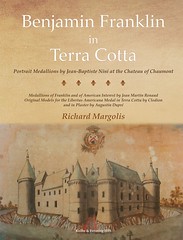 Decades in the making, a new book by Richard Margolis is now in press. Termed “brilliant” by John W. Adams, the oversize volume features fine full color illustrations throughout and is handsomely bound. Further details will be available soon. For now, a conspectus follows:
Decades in the making, a new book by Richard Margolis is now in press. Termed “brilliant” by John W. Adams, the oversize volume features fine full color illustrations throughout and is handsomely bound. Further details will be available soon. For now, a conspectus follows:
"Benjamin Franklin in Terra Cotta advances the iconographic scholarship on the portrait medallions and moulds created by Jean-Baptiste Nini, Jean Martin Renaud, and Claude Michel (Clodion). Scholars, art historians, curators and collectors will greatly benefit by acquiring Mr. Margolis's thorough and amply illustrated volume. Kudos to Kolbe & Fanning for producing a beautifully printed reference work that Franklin would certainly have found useful."
—Roy E. Goodman, Emeritus Curator of Printed Materials, The American Philosophical Society Library & Past President, The Friends of Benjamin Franklin.
NEW BOOK: THE COINS OF FORT ATKINSON
 A new book by the former curator of the American Numismatic Association suggests that the field of numismatics has much to offer modern scholarship, despite the lack of accredited numismatic educational programs in the United States. In The Coins of Fort Atkinson: A Study in Numismatic Archeology Lawrence J. Lee argues that the distain towards coin collecting by the archeological community is misplaced and that numismatists can make a solid contribution to cross-disciplinary academia. Lee uses the coins recovered from Fort Atkinson as a model for doing so.
A new book by the former curator of the American Numismatic Association suggests that the field of numismatics has much to offer modern scholarship, despite the lack of accredited numismatic educational programs in the United States. In The Coins of Fort Atkinson: A Study in Numismatic Archeology Lawrence J. Lee argues that the distain towards coin collecting by the archeological community is misplaced and that numismatists can make a solid contribution to cross-disciplinary academia. Lee uses the coins recovered from Fort Atkinson as a model for doing so.
From the book’s abstract:
“Although called both “a very exacting science” and “an academic discipline”, the field of numismatics as practiced in America has little recognized scholastic standing. While much of the rest of the world has national numismatic museums and coin cabinets curated by recognized academic scholars, America apparently only has hobbyists and charlatans on late night TV.
The lack of perceived value for numismatics is particularly apparent in the archeology of the Great Plains, where the indigenous economy was not based on bullion value, where coin hoards like those found on the eastern seaboard are basically non-existent and where coins and other numismatic items are considered to be ‘historic’ and thus intrusive to the prehistory of the region. In such a setting, any numismatic finds are often casually and inexactly described, poorly photographed and left uninterpreted as to cultural meaning or context.
After reviewing the inexact manner in which coin finds have been handled at several Plains archeology sites, this paper reexamines a published, excavated historic site in Nebraska in order to demonstrate the depth and insight a careful re-analysis of numismatic material can add to a site’s cultural as well as historic interpretation.
Fort Atkinson was at the time of its service (1819-1827) the westernmost fort in America and the earliest settlement in what is now Nebraska. It had a complex, interconnected economy that included fur trade, barter, bullion specie (including coins from many countries and mints as well as U.S. coinage), credit, lay-away plans, soldier certificates, Treasury warrants, Treasury notes, bank drafts, checks and bonds.
Over one hundred and twenty coins and coin ‘bits’ were recovered from Fort Atkinson during ten seasons of excavation. This book for the first time describes all of the individual coins from a numismatic perspective that adds significantly to the understanding of life on the military frontier and will hopefully serve as a reference tool for future archeological discoveries of numismatic items in the Great Plains region.”
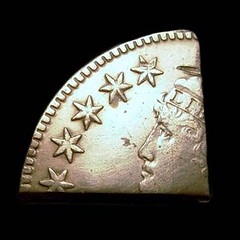 “This is a special archeological site”, Lee explained. “This was a U.S. Army post on U.S. Territory staffed by U.S. soldiers being paid mostly in uncirculated silver American half-dollars.” Some of these half-dollars were then chopped into ‘bits’ by the Army paymaster, which is possibly one of the first time the government cut up its own money to make small change. These coins and coin bits then circulated around the fort before being lost on-site, only to be archeologically recovered almost 200 years after the fort’s abandonment. One would expect that the majority of coins from the site would thus be American coinage. In fact, Lee found 90% of the coins, including those lost within the fort barracks, were Spanish colonial silver pieces.
“This is a special archeological site”, Lee explained. “This was a U.S. Army post on U.S. Territory staffed by U.S. soldiers being paid mostly in uncirculated silver American half-dollars.” Some of these half-dollars were then chopped into ‘bits’ by the Army paymaster, which is possibly one of the first time the government cut up its own money to make small change. These coins and coin bits then circulated around the fort before being lost on-site, only to be archeologically recovered almost 200 years after the fort’s abandonment. One would expect that the majority of coins from the site would thus be American coinage. In fact, Lee found 90% of the coins, including those lost within the fort barracks, were Spanish colonial silver pieces.
As an extension of his 2006 doctoral dissertation on numismatic education in the United States, Lee notes that the research is significant for several reasons. Not only is it an analysis of the coins and coin bits from an important early American historic site with multiple economies, but the book also serves as an example of the methodological structure that all standardized numismatic research needs to follow to be academically relevant: statement of the problem; review of the literature; data collection; data analysis and conclusions and recommendations.
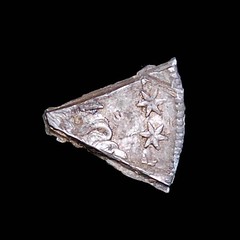 One doesn’t need to agree with the conclusions Lee says, as long as the data behind the conclusions is available for others to replicate and evaluate on their own. He notes numismatists have developed a literature and terminology that modern archeologists would profit greatly from understanding and using. Lee also challenges archeologist to question some of their own assumptions about the use of wampum on the Great Plains, how and why coins are holed and whether holed coins necessarily mean they were used as decoration by Native peoples.
One doesn’t need to agree with the conclusions Lee says, as long as the data behind the conclusions is available for others to replicate and evaluate on their own. He notes numismatists have developed a literature and terminology that modern archeologists would profit greatly from understanding and using. Lee also challenges archeologist to question some of their own assumptions about the use of wampum on the Great Plains, how and why coins are holed and whether holed coins necessarily mean they were used as decoration by Native peoples.
Carl Wolf of Chicago was a reader of an advanced copy of the manuscript and also listened to a presentation Lee gave on Fort Atkinson to the Chicago Coin Club back in October. Wolf wrote “Coin stories with an archeological perspective are always fascinating. However, most are based on coin hoards discovered in Europe or Asia. This story springs from the American frontier, today's Midwest. Lee's research into the history of Fort Atkinson and the coins uncovered among its ruins has set a high bar on numismatic archaeology. I was one of the fortunate few who read a draft of the work. I admire Lee's talented writing style; his storytelling is concise and complete.”
Dr. Lee will be in Chicago for the Central States Numismatic Show on April 22 and 23, doing a book signing at noon on both days. CSNS provided the grant that funded Lee’s research.
The book The Coins of Fort Atkinson is priced at $24.95 plus $2.95 postage ($27.90 total) and is available exclusively from Deibus Noe Publishing, P.O. Box 6171, Lincoln, NE 68506. Nebraska residents must add an additional 7% sales tax on each book. Payment can be made by check or money order, no credit cards accepted. PayPal may be an option. There is a publisher’s discount for orders of 10 or more copies. Lee can be contacted at lee@athena.csdco.com.
In the "actually-a-coin-WAS-harmed-in-making-this" department, Larry adds:
That one American bit is pretty special in that it took two whacks with the hatchet to chop it, then it had to be folded back and forth on the crevice to totally crack apart. The coin is basically uncirculated and those edges are still razor sharp.
THE BOOK BAZARRE
NEW BOOK: LATE ROMAN BRONZE COINAGE
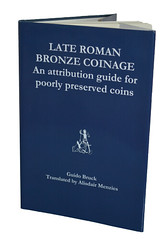 Late Roman Bronze Coinage – An attribution guide for poorly preserved coins
Late Roman Bronze Coinage – An attribution guide for poorly preserved coins
The book in question is an English translation of Guido Bruck's now out-of-print Die spätrömische Kupferprägung : ein Bestimmungsbuch für schlecht erhaltene Münzen, published in 1961.
As you probably know, Guido Bruck was curator at the Kunsthistorisches Museum in Vienna, one of the richest collections of fourth century Roman bronze coins. In addition to his role with the museum collection, he and his collaborators often had to deal with coin finds which were not of museum quality (worn, only partially legible, etc.). He therefore devised this work with a view to providing the necessary iconographical breakdown to be able to identify virtually any bronze coin of the fourth century, even in the absence of complete legends or mintmarks.
Since then, it has proved to be a valuable and popular resource, but sadly remained out of print for almost 50 years. Bruck's work was too precious to remain out of print, so I am delighted to have this opportunity to give it a second lease of life.
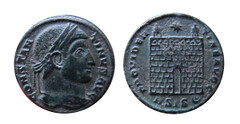 As an experienced collector of late Roman Bronze Coinage, I initially translated the work for my own purposes. Other numismatists were quick to encourage me to publish the translation. More information can be found on my website.
As an experienced collector of late Roman Bronze Coinage, I initially translated the work for my own purposes. Other numismatists were quick to encourage me to publish the translation. More information can be found on my website.
The book is available in both paperback and hardback formats
For more information, or to order, see:
Late Roman Bronze Coins – An Iconographical Exploration
(www.lateromanbronzecoins.com/)
BOOK REVIEW: SHERLOCK HOLMES & THE MASTER ENGRAVER
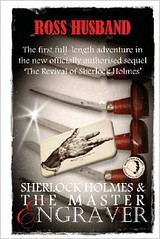 It is Christmas Eve, 1889; Sherlock Holmes becomes totally immersed in a case of the very greatest gravity when the senior partner and master engraver of London’s most eminent security printer begs his aid in investigating a crime which threatens to break the Bank of England and devastate the economy of Great Britain.
It is Christmas Eve, 1889; Sherlock Holmes becomes totally immersed in a case of the very greatest gravity when the senior partner and master engraver of London’s most eminent security printer begs his aid in investigating a crime which threatens to break the Bank of England and devastate the economy of Great Britain.
In the largest and most audacious robbery in British banking history, the newly-engraved printing plates for the next run of official Bank of England ten pound notes have been stolen, together with a vast supply of the special water-marked banknote paper- and from the outset of the case, there appear to be no clues as to the identity of the thieves. The currency of the realm is in dire peril…
The Chief Cashier of the Bank of England believes he has no option but to pay the stunning six-figure ransom demanded for their return, but Sherlock Holmes thinks otherwise…
The most illustrious consulting detective in Europe has a mere five days to unravel the mystery; recover the plates and paper, and save the nation’s economy from financial catastrophe – or pay the staggering ransom.
But there will be grim and perilous consequences; the investigation will draw Holmes and Watson deep into the vilest and most perilous rookeries of 19th century London, horrific and brutal murder will be done and in the process of the investigation Sherlock Holmes will make an implacable, murderous and life long enemy who will pursue him to the end of his days to wreak his revenge…
So reads the dust jacket blurb of Sherlock Holmes & The Master Engraver by Ross Husband. Published in 2013, this is a lively story that introduces us to a few of the main characters that we meet in later stories in the Canon timeline. I was able to read the entire 400 page during a cross-country flight from Baltimore to Los Angeles and was unable to put the book down.
This story was the first of a six part Revival of Sherlock Holmes series that Husband was planning to produce. The first two chapters of the next installment are included with this edition. Unfortunately, Husband passed away on January 20, 2014.
To read the complete article, see:
Book Review: Sherlock Holmes and the Master Engraver
(http://fourthgarrideb.com/2015/03/book-review-sherlock-holmes-and-the-master-engraver/)
For more information, or to order, see:
Sherlock Holmes & The Master Engraver
(www.amazon.com/Sherlock-Holmes-Master-Engraver-US/dp/1482790734/ref=la_B00EALAUP0_1_1?s=books&ie=UTF8&qid=1425757336&sr=1-1)
HARVEY STACK RECALLS WORKING WITH GOVERNMENT AGENCIES
Harvey Stack writes:
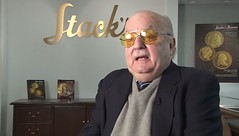 In the Fall of last year I sat down with Coin Week
and told the stories I could remember about how Numismatics was
during the 67 yrs. of my numismatic career, and how Stack's and
now Stack's Bowers strives to make the Coin Industry and Hobby
grow. I was honored to be a spokesman for us, and gave the
interview. A lot was said in the first person as I was greatly involved
with events in the past.
In the Fall of last year I sat down with Coin Week
and told the stories I could remember about how Numismatics was
during the 67 yrs. of my numismatic career, and how Stack's and
now Stack's Bowers strives to make the Coin Industry and Hobby
grow. I was honored to be a spokesman for us, and gave the
interview. A lot was said in the first person as I was greatly involved
with events in the past.
Within the last months, Coin Week introduced segments of my long interview. This week they expanded the showing of five new segments of the interview on their internet site.
- Industry Representative of Hobby Protection Act in 1973 for Numismatics.
- Working with Government Agencies in the Coin Trade.
- My Work for the US Assay Commission.
- Debating the Federal Trade Commission about Coin Dealer Regulation.
- Success of the Statehood Quarter Program.
To view the videos, see:
Numismatic Personalities – A Conversation with Harvey Stack – Working with Government Agencies
(www.coinweek.com/education/numismatic-history/numismatic-personalities-a-conversation-with-harvey-stack-working-with-government-agencies/)
To read the previous E-Sylum article, see:
COINWEEK INTERVIEWS HARVEY STACK
(www.coinbooks.org/esylum_v18n08a14.html)

Archives International Auctions, Part XXIII
U.S. and Worldwide Banknotes, Security Printing Ephemera and U.S. Federal Bonds and Documents.
Highlights include:
- Possibly Unique As Issued 1866 Gold Coin Note
- Spectacular American Bank Note Co. Advertising Sheet in Spanish
- United Arab Emirates Currency Board, 1973
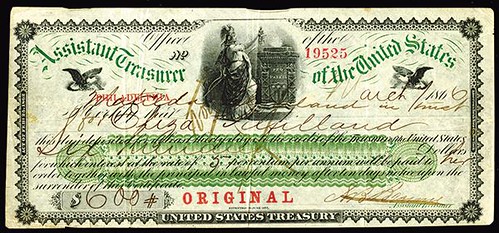
1580 Lemoine Avenue, Suite #7
Fort Lee, NJ 07024
Phone: 201-944-4800
Email: info@archivesinternational.com
WWW.ARCHIVESINTERNATIONAL.COM
SMITHSONIAN NUMISMATIC GALLERY TO OPEN JULY 1, 2015
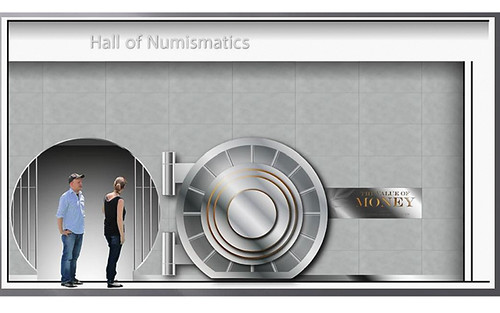
A vault door will mark the entrance to the National Museum of American History's new Gallery of Numismatics and its inaugural exhibition, "The Value of Money." Opening July 1, the gallery will delve into the National Numismatic Collection (NNC)—one of the Smithsonian's oldest and most treasured collections—to uncover stories related to the origins, innovations, messages, artistry and allure of money.
"The Value of Money," will be part of the museum's history-plex of galleries, experiential learning places and performance spaces centered on the theme of innovation. It will showcase more than 400 objects from the NNC, some of which are among the rarest in the world. The exhibition will link American history to global histories of exchange, cultural interaction, political change and innovation. Thematically organized into five sections, the exhibition will allow visitors to learn about the origins of money, new monetary technologies, the political and cultural messages money conveys, numismatic art and design, and the practice of collecting money.
"While 'The Value of Money' exhibition will honor some of the most monumental currencies in the world, it will also allow visitors to connect with the cultural impact money has made in advancing American society into the nation it is today," said John Gray, director of the museum.
Featured American objects will include a storied 1933 Double Eagle, a personal check signed by President James Madison in 1813, a 1934 100,000 dollar note and a Depression-era one dollar clam shell. International artifacts include a 465 BC Decadrachm coin from Syracuse, Sicily, a 14th-century Ming Note from China and a 1626 8 Real Coin from Bolivia, known as a Spanish Piece of Eight.
The museum's numismatics curators are documenting emerging monetary technologies to show how methods of payment have evolved from coins and paper money to increasingly cashless transactions. One of the recent acquisitions that will be included in the exhibition is a small plastic device called a Square Reader. It plugs into a mobile device through an audio jack and processes credit transactions for debit and credit cards. With the use of a mobile application, small and mobile businesses have the ability to process a purchase through a smart phone or tablet with a swipe of a credit card.
Square technology was invented by entrepreneur Jack Dorsey and computer science engineer Jim McKelvey. The idea emerged because McKelvey, who also is a glass artist, was having difficulty accepting large payments for the sale of his artwork. When unable to process credit card payments from his clients, he and Dorsey began working on a portable and inexpensive method of processing debit and credit card sales. A recent donation by Square has provided the NNC with several versions of Square technology.
"Around the world, emerging monetary technologies are increasingly allowing individuals to make payments via their phones, tablets and computers," said Ellen Feingold, curator of the exhibition. "By changing how people make payments, these new technologies are also affecting how people interact with each other and conduct commerce, both locally and globally."
The world-class NNC collection of more than 1.6 million objects was made possible by transfers from the U.S. Treasury, the U.S. Mint and the U.S. Bureau of Engraving and Printing as well as through donations from private collectors.
"The Value of Money" exhibition is made possible through the leadership support of Bill Gale, the Lilly Endowment Inc., Lee and Saundra Minshull, Charles and Hilda Anderson, Joel and Carmen Anderson, the Numismatic Guaranty Corp., Dr. and Mrs. Andrew A. Shiva, Stack's Bowers Galleries, Vault Structures Inc., Jeff and Mary Lynn Garrett, Crane & Co., Brian and Barbara Hendelson, The Noxon Family, and PMX Industries, as well as an anonymous donor and other contributions from the numismatic community.
Through unrivaled collections, rigorous research and dynamic public outreach, the National Museum of American History explores the richness and complexity of American history. The museum helps people understand the past in order to make sense of the present and shape a more humane future. For information, visit http://americanhistory.si.edu. Located at 14th Street and Constitution Avenue N.W., the museum is open daily from 10 a.m. to 5:30 p.m. (closed Dec. 25).
Chris Fuccione writes:
Anyone up for a road trip? I haven't been to the Smithsonian's National Numismatic Collection for about six years and can't wait to see what they did with this new display.
To read the complete press release, see:
Measuring Worth at the Smithsonian's National Museum of American History
(www.prnewswire.com/news-releases/measuring-worth-at-the-smithsonians-national-museum-of-american-history-300045075.html)
To read the earlier E-Sylum article, see:
SMITHSONIAN NUMISMATIC GALLERY TO OPEN JULY 2015
(www.coinbooks.org/esylum_v17n18a09.html)
NOTES FROM E-SYLUM READERS: MARCH 8, 2015
The Most Interesting and Comprehensive Numismatic Publication Fred Michaelson writes:
Have I told you lately that you create the most interesting and comprehensive numismatic publication in the history of numismatics, exonumia, & c., single-handed and all by yourself, every week, that no other publication can compete with? Well, you do.
Arlie Slabaugh: Deaf, But Not Mute Tom DeLorey writes:
A slight correction to David Alexander's article on The Numismatic Scrapbook. Arlie Slabaugh was not mute. His speech had a curious lilt to it on account of his never having heard the normal cadence of human speech, but he was fully conversant.
To read the earlier E-Sylum article, see:
THE RISE AND FALL OF NUMISMATIC SCRAPBOOK MAGAZINE
(www.coinbooks.org/esylum_v18n08a07.html)
On the Subject of Changing the Subject Regarding last week's item about Argentina's new banknote, Kenneth Berger writes:
In my present position as a Geography Professor, one of the courses I teach is World Regional Geography. It is a well-known fact that, every time Argentina experiences an economic downturn, the government raises the issue of the Falkland Islands (i.e. Islas Malvinas to Argentina) so as to get the populace to think (& complain) about something else. In fact, I just finished teaching my class about this last week. Too bad I didn't have one of the new notes available to show them.
To read the earlier E-Sylum article, see:
ARGENTINA'S NEW BANKNOTE RILES FALKLAND ISLANDERS
(www.coinbooks.org/esylum_v18n09a27.html)
On Ordering Hungarian Coins and Coin Books Richard Crosby writes:
It is very easy to order Hungarian coins, in base medal, and in silver You can also order the proof and mint sets and currency. They also sell medals and Hungarian coin books. They have very good prices compared what you have to pay in the States for them.
You can also have your name placed on pre-order list annually (this I recommend). You will be notified in advance when the coins become available. Most coins have a very low mintage between 3000-5000 pieces. Very nice detail. I have been doing this for the past 10 years and never had a problem. eMail is coins@hu.inter.net Web site is www.penzvero.hu Fax 36-1-800-8113-210-4448. Note if you go to the web site and register you can have the option to select English and not Hungarian.
To read the earlier E-Sylum article, see:
FOLLOW-UP ON SEARCH FOR CURRENT WORLD COINS
(www.coinbooks.org/esylum_v18n06a15.html)
The Old Binion's $Million Display
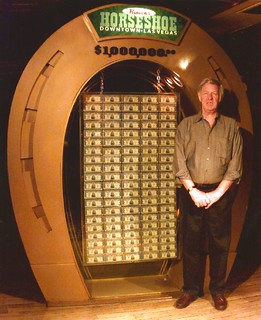
To read the earlier E-Sylum article, see:
NOTES FROM E-SYLUM READERS: MARCH 1, 2015: Binion's Current $Million Display
(www.coinbooks.org/esylum_v18n09a12.html)
Query: Pugachev Rouble in Copper Information Sought Steve Bishop writes:
I have a coin that purports to be a Russian "Pugachev" rouble in copper (picture below). It is struck over a copper 5 kopeck piece of Catherine II. Diameter - 41 mm. Weight - 44.45 gr, Netted edge. The Bitkin number is H-1001. If genuine, this is a very rare coin, R4 with less than 10 known. I would like to hear from anyone who can give me more information about this piece, such as: how do I determine it is genuine, known fakes, etc. Readers can email me at
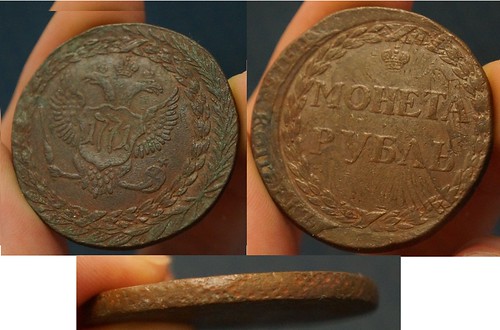
Daily Mail Covers the Pogue Collection
 Dick Hanscom forwarded this article from London's Daily Mail about the upcoming Stack's-Bowers sale of the Pogue collection. Thanks. The word has traveled far!
-Editor
Dick Hanscom forwarded this article from London's Daily Mail about the upcoming Stack's-Bowers sale of the Pogue collection. Thanks. The word has traveled far!
-Editor
To read the complete article, see:
Rare five-dollar gold piece from 1822 and 200-year-old silver dollar expected to rake in $10million at auction
(www.dailymail.co.uk/news/article-2985048/Flipping-coin-rare-U-S-coin-market-hits-records.html)
I-95 Armored Truck Gold Heist
Shortly after dusk along a lonely stretch of Interstate 95, armed robbers hijacked an armored truck, tied up the two guards and disappeared into the night with 275 pounds of gold bars.
The guards working for Transvalue Inc. of Miami reported pulling off to the side of the interstate about 6:30 p.m. Sunday after their vehicle began having mechanical problems in eastern North Carolina, according to the Wilson County Sheriff's Office.
The guards told police they were surprised by three armed men driving a white van who ordered the guards to lie on the ground, tied their hands behind their backs and then marched them into nearby woods.
The robbers then helped themselves to barrels filled with about $4.8 million in gold before making their getaway. Transvalue said its employees were not injured during the heist.
To read the complete articles, see:
$4.8 million in gold stolen from truck in North Carolina
(www.wcvb.com/news/4-million-in-gold-stolen-from-truck-in-north-carolina/31565516)
Armed heist nets $4M in gold, triggers N.C. manhunt
(www.usatoday.com/story/news/nation/2015/03/02/gold-robbery-north-carolina/24264801/)
911 callers describe chaos after gold theft on NC highway
(www.wcvb.com/news/911-callers-describe-chaos-after-gold-theft-on-nc-highway/31598320)
GASPARRO'S 1976 BICENTENNIAL GOLD MEDAL
Stack’s Bowers Galleries is the official auctioneer of the 2015 American Numismatic Association (ANA) National Money Show and will conduct an auction featuring more than 1440 lots that covers a range of U.S. and colonial coins, patterns, private issues and medals.
The auction kicks off at 6:00pm Pacific Standard Time (PST) (9:00pm Eastern) and begins with a seemingly innocuous, but curiously seldom-seen modern gold medal issued in 1976 by the United States Mint.
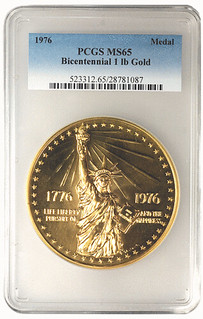 1976 National Bicentennial Medal
1976 National Bicentennial Medal
Lot 1. Gold 76.2mm. 455.49 grams. Swoger-521a. Numbered 270 on Edge. PCGS MS-65
Weighing in at 13.18 troy ounces, this large 1976 National Bicentennial Gold Medal was a costly, much neglected and subsequently maligned official medallic offering from the U.S. Mint. Accounts differ on the final mintage of the piece (some read 423, others 424). Compare that to the .415 troy ounce version of the same design–of which 16,181 were sold–and there’s no question that this 1976 Frank Gasparro work was born scarce.
Scarcer still are the apparent few that survive. For whatever reason (some speculate the run on gold in the 1980s led many to be melted), this large format medal appears infrequently on the market. We’ve tracked down a handful of examples but hardly enough to determine a market price for the piece.
In 2008, Heritage offered one, which it described as rare. That medal changed hands for its value in gold at the time.
It wasn’t until 2014, at the February Stack’s Americana Sale in New York city, that we found another public transaction. That example was graded MS-67 by PCGS and came out of the Charles A. Wharton Collection. At the time of that sale, the medal contained approximately $17,305 USD worth of gold. The medal brought $32,400 with buyer’s premium- a sizable numismatic premium the second go around.
What the present issue brings is anybody’s guess. Our hunch is $24,000 to $26,000, if it sells. PCGS graded it MS-65.
The design itself does not inspire; Gasparro’s art rarely did.
But it’s competent in a dated sort of way, and reminiscent of the many bicentennial gewgaws and knickknacks marketed at the time – a time that feels ever more distant as we enter the latter half of the second decade of the 21st century.
To read the complete article, see:
Stack’s Bowers to Offer Seldom Seen Bicentennial Gold Medal at ANA National Money Show Auction
(www.coinweek.com/coins/medals-and-tokens/stacks-bowers-to-offer-seldom-seen-bicentennial-gold-medal-at-ana-national-money-show-auction/)

SUBSCRIBER PROFILE: JOHN HUMPHRIS
Here is an outline of my numismatic experience. I lived in Birmingham, England until 1966 when I emigrated to Canada after being invited to join a numismatic company called 'Collectors Research' owned by Dr. Kenneth Gaver near Montréal. In 1970 I was asked to join the 'World Wide Coin Company' in Montréal, which imported coins wholesale from all over the world and exported them to mostly wholesale dealers in many countries. Here I became vice-president and traveled to several countries on business including India.
My wife, Margaret and I first met the Katens in 1966 when they visited Collectors Research in Montréal, and we visited them a few times in Silver Spring. I bid on many books over the years in their auctions. Right at my side is a collection of U. S. Mint Reports from 1888 to 1923 on which I successfully bid. I did not want them for information on U. S. coins, but for the detailed history of foreign coins that they contain.
In 1974 Oliver Amos, the owner of Amos Press, asked my wife and I to report on the Canadian Numismatic Society Convention in Hamilton, Ontario. I sent him our report, and soon after he asked us to join Amos Press and began proceedings for us to immigrate. Fortunately the U.S. consul in Montréal was also a member of the Montréal Numismatic Society of which I was president, and he facilitated the immigration proceedings which took 15 months instead of the usual two years. My wife was secretary of Montréal Numismatic Society and president of Lakeshore Coin Club, a western suburb of Montréal.
The U.S. consul was none other than Harrington Manville. We used to meet him at the U. S. Consulate with Jerome Remick for coin research meetings 1973-1975. We were sorry to read about his death in The E-Sylum. He was an old friend of ours but we had been out of touch for some years. He was in the U.S. diplomatic corps as mentioned in his obituary, but he was also in other government services.
We were at a show in Silver Spring and we went into Washington to meet him. He wanted to show us certain things, but after a while he told us that he had to leave us and we could not follow him. I suspect that he was called to one of those intelligence service offices. He was interested in me because I can read Anglo-Saxon and its special script, and Middle English and its various scripts, to aid him in researching the origin of English coinage and its weights.
We arrived in Sidney, Ohio in 1975 where I was assistant editor of World Coins magazine for which I had written articles over the past years. My wife became the coin society writer for societies all over the U.S.A. for Coin World newspaper. In 1976 Courtney Coffing, the editor of World Coins left Amos Press to join Krause Publications like Russ Rulau before him, and John Amos decided to terminate the magazine. We were in contact with Russ Rulau since 1964. For a time I worked for Coin World under Margo Russell, then we left Amos Press, but I continued to write monthly articles for Coin World from home. My wife and I still attend bimonthly meetings of the Amos Press Retirees Club.
Margaret and I were contributors to the first edition of Coin World Almanac in 1976. I wrote about everything to do with foreign (non-U.S.) coins and paper money for the Almanac, and Margaret compiled and wrote about U.S. and international coin club meetings and addresses. Margaret researches world coins for the history and geography they depict.
We became full-time foreign coin and paper money dealers from 1978, traveling all over the U.S.A,, Canada, and the U.K. until we were robbed of our stock in New Jersey in 1987. Before this I started to contribute information to Colin Bruce for the Krause Publication's Standard Catalogs of World Coins and Standard Catalogs of World Paper Money mostly on the weights, finenesses of the coins, and translations of these items, until 1997.
I collected my first coin in 1949, an Anglo-Saxon silver penny, and I expanded the collection to all British coins, then foreign coins and paper money. I began to write about numismatics in 1967 with my first booklet published by 'Collectors Research' on The Currency of Iraq, followed by another booklet It's Fun to Collect Foreign Coins. I began to write for World Coins magazine in about 1972, and Coin World from 1976 to 1987. I have had several hundred articles published in magazines and newspapers, and in Numismatics International, International Bank Note Society, Banknote Reporter, Numismatic Scrapbook, and Whitman Numismatic Journal, for which I have received awards. I am a life-member of the Numismatic Literary Guild which I joined on August 1, 1976 on the recommendation of Ray Byrne.
I have co-authored three books on foreign paper money with Masahiro Tomita, published in Japanese. I translate texts on foreign bank notes for him, and explain the story of the illustrations on the notes, which he publishes. The latest story I did for him was translating some current Armenian notes and explaining the saints on them. I can type and translate over 100 languages, and my formal education was in metallurgy, printing, and graphic design.
I have compiled a research library on European, Islamic, and Asian numismatics since around 1964. I have hundreds of books on international numismatics, finances, history of countries, historical geography, atlases (including one huge one with wooden covers from 1878, hand-colored), militaria, flags, heraldry, and about seventy languages.
I specialize in translating the coins and banknotes of countries using the Arabic and Cyrillic scripts, and the countries of the former U.S.S.R. I did some translations of notes and coins, mostly Islamic, for Dr. Clain-Stefanelli in the Smithsonian Institution; and for coins and paper money of Xinjiang for Marion Archibald in the British Museum and the Ashmolean Museum in Oxford, England in the early 1960's . We were founder members of Birmingham Numismatic Society, England, in 1964.
I have given several lectures to societies, and a special presentation in 1987 to Thomas Ferguson, director of the Bureau of Engraving and Printing, talking about and illustrating by examples the security features used in foreign bank notes, such as watermarks (used in British banknotes since the 1690's), metal strips embedded in the paper (used in British notes since World War II), metallic inks using rare minerals, metallic color-shifting inks, etc. - all of which were not used in U.S. banknotes at that time, and all have since been adopted, except for using polymer instead of paper.
ATHELSTAN SPILHAUS: INVENTOR, ENGINEER, CARTOONIST
Regarding the 1964 cartoon about coinage published last week, Kenneth Berger writes:
From my days as an oceanographer, I thought the name "Athelstan Spilhaus" rang a bell, and it did. Prof. Spilhaus started NYU's Meteorology and Oceanography Dept. at the old University Heights campus in the Bronx (my alma mater). More importantly, however, he was the inventor of the bathythermograph. This was an instrument which allows for temperature measuring at various ocean depths. Its original purpose was to aid in the detection of German U-Boats during WWII. Although they have been replaced by more sophisticated instruments, they still make for interesting discussions and in some circles are considered a collectible. I myself have one. He was also the engineer-in-charge of the weather balloon that sparked the Roswell, N.M. incident about a crashed UFO.
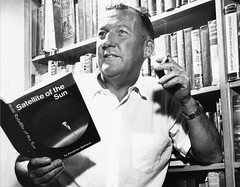 When Dr. Athelstan Spilhaus met President Kennedy in 1962, JFK told him, “The only science I ever learned was from your comic strip in the Boston Globe.”
When Dr. Athelstan Spilhaus met President Kennedy in 1962, JFK told him, “The only science I ever learned was from your comic strip in the Boston Globe.”
The comic strip that Kennedy was referring to was called “Our New Age” and ran in about 110 Sunday newspapers all around the world from 1958 until 1975. Much like Arthur Radebaugh‘s mid-century futurism comic “Closer Than We Think,” which ran from 1958 until 1963, “Our New Age” was a shining example of techno-utopian idealism. Not all of the strips were futuristic, but they all had that particular brand of optimism that so characterized postwar American thinking about science and technology.
Each week the strip had a different theme, illustrating a scientific principle or advancement in an easily digestible way. Some of the strips tackled straightforward scientific topics like meteors and volcanoes, while others explained the latest scientific developments in synthetic fibers, space travel and lasers. The strip seemed to say that the building blocks of the future were laid out before us, we just had to build it.
As Spilhaus tells it, he was inspired to start the comic strip in October of 1957 after the Soviets launched Sputnik — the first human-made satellite — into space. He was concerned that American kids weren’t showing enough interest in science and technology. “Rather than fight my own kids reading the funnies, which is a stupid thing to do, I decided to put something good into the comics, something that was more fun and that might give a little subliminal education,” he said.
“Our New Age” had an enormous audience almost immediately. A 1959 article in Time magazine noted that the strip appeared in 102 U.S. and 19 foreign newspapers.
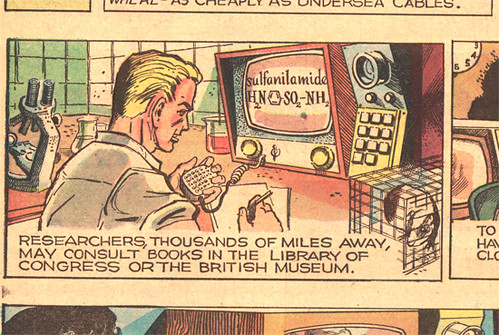
During the majority of the time that he was writing “Our New Age,” Dr. Spilhaus was the dean of the University of Minnesota’s Institute of Technology. While in Minnesota, Spilhaus became good friends with another under-appreciated futurist thinker, journalist Victor Cohn. People were constantly asking Spilhaus, a jet-set man who had his hand in everything, how he could be involved in so many seemingly disparate projects. He told his friend Victor, “…I don’t do ‘so many things.’ I do one. I think about the future.”
The December, 1971 issue of Smithsonian magazine published a profile on Dr. Spilhaus and mentioned that some weren’t so pleased that a distinguished academic was writing Sunday comic strips. The articles notes that his writing “Our New Age” was, “thought by some an undignified avocation.”
Dignified or not, there’s no question that influencing an American president, and reaching a worldwide audience with a message promoting science was no small feat. Spilhaus himself responded to the academics who questioned his supposedly undignified side project: “Which of you has a class of five million every Sunday morning?”
To read the complete article, see:
Sunday Funnies Blast Off Into the Space Age
(www.smithsonianmag.com/history/sunday-funnies-blast-off-into-the-space-age-81559551/?no-ist)
To read the earlier E-Sylum article, see:
1964 COMIC ABOUT COINS AND COLLECTORS
(www.coinbooks.org/esylum_v18n09a24.html)
NEW U.S. STAMPS ILLUSTRATE MEDAL OF HONOR
 For collectors of medals on stamps May 25th will be a red-letter day. That's the first day of issue for a stamp that the Post Office has out done itself for -- the most creative "package" of stamp design marketed directly with the collector in mind.
For collectors of medals on stamps May 25th will be a red-letter day. That's the first day of issue for a stamp that the Post Office has out done itself for -- the most creative "package" of stamp design marketed directly with the collector in mind.
They hit me right between the eyes. I have collected medals on stamps ever since George Fuld owned a stamp dealership in the 1980s and sent me approvals. I will be first in line at the Post Office on May 25th. Here's why I'm so excited:
The Post Office is calling this stamp issue a "four page prestige folio." It illustrates the U.S. Medal of Honor, our nation's highest military decoration. There are three versions, one for each branch of the military (the Marines share the same medal given to Navy honorees). The Army and the Air Force each have their own version of he medal.
But what is so unusual is that each of the four sheets in the folio illustrate 12 of the 48 living Medal of Honor recipients. Photographs of living persons surround the 12 stamps -- four each of the three versions of the Medal of Honor. The stamps are the Post Office's Forever Stamp.
Isn't that a creative idea? Recipients of the Medal of Honor receive a number of privileges along with the medal around their neck (generals have to salute them for one!). But to be pictured on millions of American stamp pages is an unprecedented Honor.
The Medal of Honor is not the first decoration to appear on an American stamp, the Purple Heart stamp of 2012 predates it. Perhaps the new stamp however will attract more collectors to the philatelic topic of medals on stamps.
The American Topical Association which chronicles all topical stamp collecting, has record at last count of 847 stamps illustrating medals and awards.. Not quite as popular as coins and currency on stamps with a record of 1,327.
But if I have convinced any reader to acquire this four-page folio, get behind me. I am first in line.
To read the complete article, see:
MEDAL OF HONOR: VIETNAM WAR
(http://uspsstamps.com/stamps/medal-honor-vietnam-war)
THE BOOK BAZARRE
ROYAL MINT UNVEILS NEW PORTRAIT OF QUEEN ELIZABETH
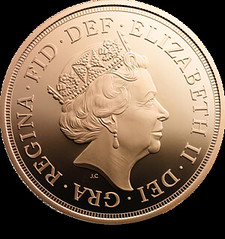 The Royal Mint has today unveiled a new coinage portrait of Her Majesty The Queen, giving the general public the first glimpse of the image that will soon be a familiar sight on United Kingdom coins.
The Royal Mint has today unveiled a new coinage portrait of Her Majesty The Queen, giving the general public the first glimpse of the image that will soon be a familiar sight on United Kingdom coins.
This is only the fifth definitive portrait of The Queen to appear on our circulating coins since her accession to the throne in 1952, making it a very rare event indeed. When it appears in our change later this year, it will become the fourth portrait currently in circulation, joining those created in 1968, 1985 and 1998; together, the coins that carry them tell the story of Her Majesty’s lifetime and paint a compelling picture of the story of her reign.
It has also been revealed today that the new portrait is designed by Jody Clark. He is the first Royal Mint engraver to be chosen to create a definitive royal coinage portrait in over 100 years.
Just 33 when his design was selected from a number of anonymous submissions to a design competition, Jody is the youngest of the five designers to have created the portraits of The Queen that have appeared on UK circulating coin during her 63 year reign.
Adam Lawrence, Chief Executive of The Royal Mint, said: “This change of royal portrait will make 2015 a vintage year for UK coins, and it will be hugely exciting for us all to see the new design appear on the coins we use every day.
“Jody’s achievement is something that we can celebrate as a proud moment for The Royal Mint. Capturing a portrait on the surface of a coin demands the utmost skill, and is one of the most challenging disciplines of the coin designer’s art. The last Royal Mint Engraver to be commissioned to undertake a royal portrait was George William de Saulles, who engraved the portrait of Edward VII which first appeared on the coinage in 1902”
To read the complete article, see:
The fifth portrait of The Queen is unveiled
(http://blog.royalmint.com/the-fifth-portrait-of-the-queen-is-unveiled/)
Philip Mernick writes:
Hooray, no more Mrs Grumpy, the Queen CAN smile!
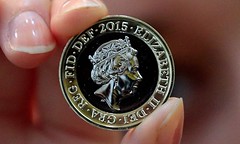 Time has finally caught up with Queen Elizabeth II – on her money at least. Her profile is visibly aged in a new coin portrait by Jody Clark. The royal image on Britain’s coinage will, when this design goes into circulation, be unmistakably that of an 88-year-old, including prominent wrinkles.
Time has finally caught up with Queen Elizabeth II – on her money at least. Her profile is visibly aged in a new coin portrait by Jody Clark. The royal image on Britain’s coinage will, when this design goes into circulation, be unmistakably that of an 88-year-old, including prominent wrinkles.
The dignity of the regal image can surely survive this numismatic realism. With her crown, big earring and half smile the Queen looks as quietly authoritative on her latest coins as she did on her first in 1953. The Royal Mint has changed her face just four times since then. Even these reluctant remodellings maintained an impression of timeless classical grace that made the ageing process almost unnoticeable – until now.
In fact, the Queen has been idealised on her coinage far more than ancient rulers ever were. This is the first fiscal image of her entire reign that lives up to the realism of ancient Roman coin portraits of emperors. Nero, for instance, looks fat and puppyish on his coins. They fit his reputation as a baby-faced psychopath. Romans liked their portraits realistic – the Capitoline museum in Rome has rooms full of ugly senators – and the imperial image on coins was frank because it needed to be authentic. Money must be the real thing.
To read the complete article, see:
The Queen shows her age as portrait is updated on coins
(www.theguardian.com/uk-news/2015/mar/02/the-queen-portrait-updated-on-coins)
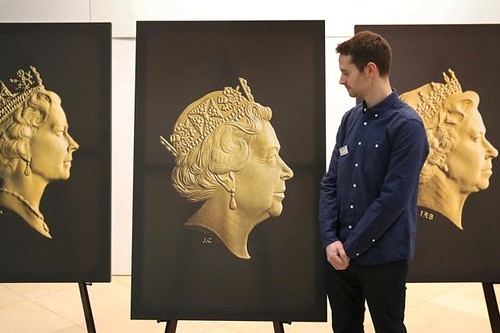
The Queen is looking happy. And in millions of pockets and purses and piggy banks, she will continue to do so for the rest of her reign.
The new portrait to appear on British coins was unveiled yesterday. It might show the Queen looking somewhat older and more lined, but also shows a warmer, less stern monarch than the version of the past 17 years.
It is the work of Jody Clark, 34, the youngest engraver to have created an image of the Queen on UK coins during her 63-year reign.
“I wanted to have a bit more of a warmer expression,” said Mr Clark, from Bowness-on-Windermere. “I just thought that was fitting.
“This is probably a final portrait. It’s quite nice to have one that’s a little bit more positive.” The portrait, the fifth of the Queen created for the nation’s coinage, replaces one unveiled in 1998 by Ian Rank-Broadley, who said his version should be “a recognisable one, and not over-idealised”.
If the Queen is looking less grumpy than she did 17 years ago, it may be because she has been treated relatively kindly: there are a few more lines, but not so many that an 88-year-old woman would have cause for complaint.
The new portrait is the first to have been designed entirely on computer, not to mention the first created by a former designer of supermarket packaging. It shows the Queen wearing the diamond diadem worn for the Coronation, a deliberate decision to make “some clear distinctions” from the 1998 portrait, in which she is wearing the Girls of Great Britain and Ireland tiara.
As well as an attempt to make the two portraits look different, it was also a reference to the image created by Raphael Maklouf for coins in 1985, in which she was last shown wearing the diadem. “It’s a real nod to the past,” said Mr Clark.
Coins bearing the new portrait, the fifth since her accession to the throne in 1952, will be in circulation towards the end of the year — probably after September 9, when she becomes Britain’s longest-serving monarch.
To read the complete article, see:
In mint condition at the age of 88: no wonder why the Queen is smiling
(www.thetimes.co.uk/tto/news/uk/article4370235.ece?shareToken=9d847e377375c4a4b4090bc4cc39fbb1)
INTERVIEW WITH ROYAL MINT COIN DESIGNER JODY CLARK
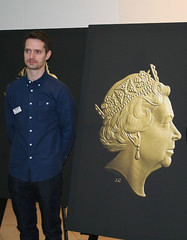 The news that a new effigy of the Queen would be introduced by the Royal Mint this year made national news headlines in the UK as there hasn’t been this kind of change to British coinage since 1998. Michael Alexander of the London Banknote and Monetary Research Centre went to the unveiling to see firsthand the new portrait which will be included on British coinage from now on and to also speak with its designer, Jody Clark.
The news that a new effigy of the Queen would be introduced by the Royal Mint this year made national news headlines in the UK as there hasn’t been this kind of change to British coinage since 1998. Michael Alexander of the London Banknote and Monetary Research Centre went to the unveiling to see firsthand the new portrait which will be included on British coinage from now on and to also speak with its designer, Jody Clark.
Jody Clark, a talented engraver/artist at the Royal Mint took center stage during the launch to show off his work to the world, his own creation of the Queen’s effigy which sees her Majesty with what has already been described as having a “smile” or warm expression. At 33, Clark is the youngest ever artist to have his coin portrait chosen and is also the first Royal Mint engraver to have their work used for this purpose since 1902. Since embarking on his career at The Royal Mint in September 2012, Jody has worked on some notable projects such as the medals struck to celebrate the 2014 Ryder Cup and NATO Summit which was held in Wales and given to attending dignitaries as well as on commissions for Costa Rica, Tanzania, Lesotho and Azerbaijan. His celebrated contemporary interpretation of the iconic Britannia adorned the coin’s 2014 proof collection.
During the unveiling, we had an opportunity to sit down and discuss the day’s events as well as the process of creation for such an important and history-recording event. I suspect we will be seeing a lot more of Jody’s work in the future so, as I usually say… watch this space for more information
MA: This, the fifth numismatic portrait of Her Majesty has already been described by today’s assembled audience as very traditional and finely detailed, – was there any specific characteristic of the Queen that you wanted to feature above anything else & do you think you’ve accomplished this..?
JC: Just the likeness which was the main thing I wanted to achieve, an accurate representation, that’s what I had in mind from the start of the project. Also, I wanted to get the expression right…
MA: Some have described her expression as almost smiling, was that an intention..?
JC: Not so much smiling as perhaps a warm expression differing from the last portrait. It was also hard to get the lettering surrounding the portrait right; in fact I probably spent almost as long on that as the portrait itself because it’s not my area of expertise. I took advice from an expert at the RMAC who made suggestions to enhance the design, like linking the letters at the bottom of the portrait.
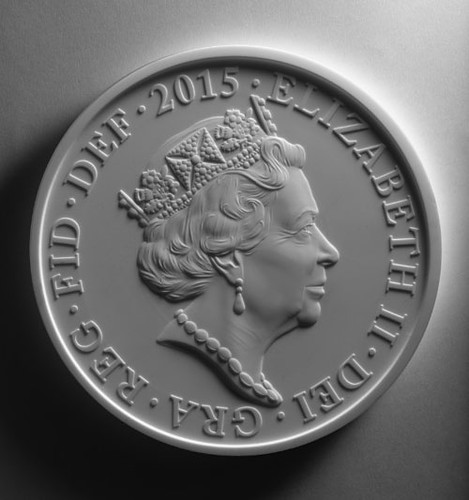
The plaster model
MA: You and the rest of the country have seen the other four portraits used on British coinage, was there any element of those previous portraits which you took a bit of inspiration from..?
JC: I definitely studied the previous ones, I wanted my portrait to “work” almost as fitting into a set so to speak, I wanted it to work together with the other representations as well as on its own so I did have them in mind when I designed this portrait. I printed them all out for reference to make sure they all worked together as a set of effigies. That’s when I made the decision to include the same crown as Maklouf for consistency.
To read the complete article, see:
Interview with Jody Clark, Designer of the New Queen Elizabeth II Effigy
(http://news.coinupdate.com/interview-with-jody-clark-designer-of-the-new-queen-elizabeth-ii-effigy-4709/)
STACK’S BOWERS AND PONTERIO’S APRIL 2015 HONG KONG AUCTION
Stack’s Bowers and Ponterio’s April 2015 Hong Kong auction will entice bidders with a total of 2,077 lots of Chinese and Asian coins and banknotes from ancient to modern times, in four live Showcase sessions and two internet-only sessions.
Session A commencing at 10:00 a.m. Hong Kong time on Monday, March 30, 2015 (7 p.m. PT Sunday, March 29), begins with non-Chinese Asian coins. Important highlights such as lot 10013, a 4-piece proof set of Burma dated 1852, will turn heads, as will lot 10040, an 1865 Pattern Hong Kong Dollar. A rare 1945-I 10 Cent of Malaya, graded EF-45 by PCGS appears as lot 10108, and an incredibly rare Gold 2 Baht of Thailand, nd (1864) will cause a stir when lot 10124 is sold. Following the World Coins is a selection of Ancient Chinese coins and Sycee. A very rare and important gold medal commemorating the establishment of the Fuzhou Arsenal, circa 1874 (quite large and impressive at 51.81 mm, 90.07 grams) will be the centerpiece of the next cabinet it graces and is the start of a selection of Chinese medals, orders, and decorations.
Among the many highlights from the W&B Capital Foundation consignment is lot 10197, an extremely rare 1900 Peking Mint Pattern Dollar, certified by NGC as MS-63. A very rare and popular “Reverse Dragon” Pattern Dollar of 1911, graded MS-63 (NGC), is a coin missing from many important cabinets of Chinese rarities, and will likely see fierce and spirited bidding before finding its new owner. What is often referred to as “the first Dragon Dollar of China,” the circa 1889 7 Mace 3 Candareens piece of Kwangtung, will appear as lot 10242. Kwangtung was the first provincial mint to utilize modern coinage equipment, contracted from the Heaton Mint in Birmingham, England. These 7 and 3 silver dollars were struck with a higher silver content than the Mexican 8 reales then in circulation in order to drive them out. When this was done, the standard was reduced to the 7 mace and 2 candareens content that became standard. This first “Dragon Dollar” is also historically important as the earliest Chinese dollar to feature the dragon motif that became the standard as well.
Concluding Session A are the General Issues of the Imperial and Republican Governments. Lot 10257 features one of the most important of Chinese “milled” or machine produced coinage, an Imperial Pattern Tael struck at the Tientsin Mint in the 29th year of Hu Poo (1903). This specimen is of the utmost rarity and is tied for the finest certified by PCGS at Specimen-63. Another important Imperial era pattern, lot 10304, is a lovely Specimen 1911 50 Cent in silver; this piece was donated to the American Numismatic Society (New York) in 1937, and is a duplicate from their vast collection. Republican issues are highlighted by lot 10433 a Gem Prooflike Small Characters Dragon and Peacock Dollar, graded NGC MS-65 PL; lot 10437 a silver Pattern “Mausoleum” Dollar graded AU-55 (NGC); and lot 10438, a very rare Specimen Italian pattern Sun Yat-Sen Junk Dollar, signed by A. Motti and graded by PCGS as Specimen-63.
7 Mace 2 Candareens (Dollar) Pattern, CD (1900).
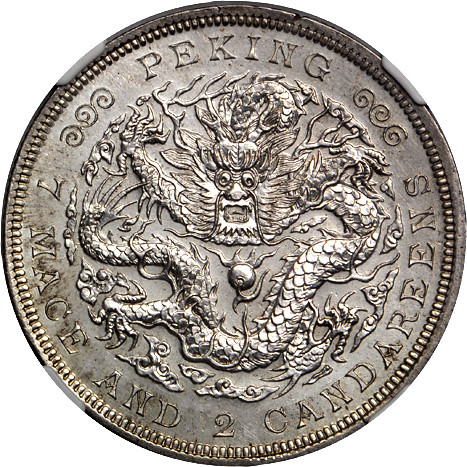
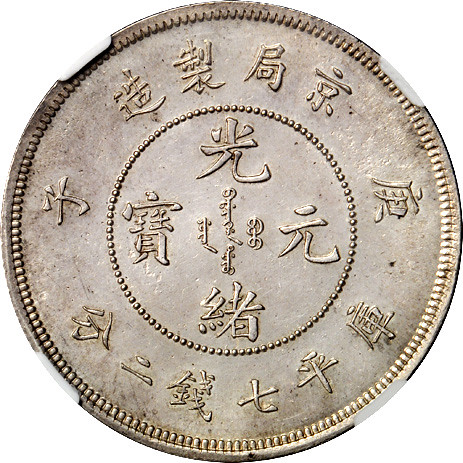
Kwangtung. 7 Mace 3 Candareens (Dollar), ND (1889).
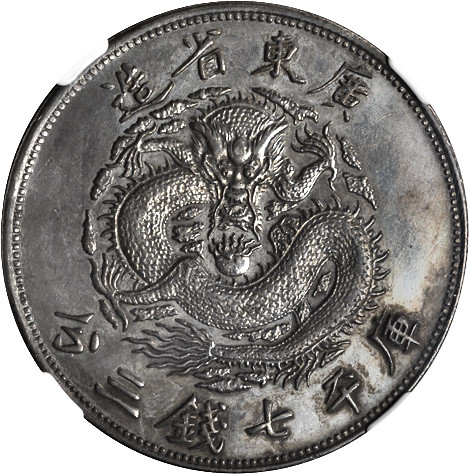
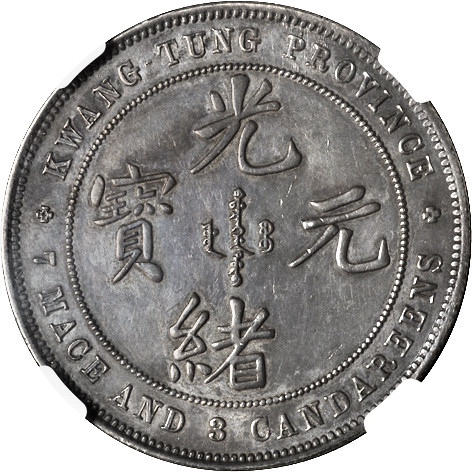
Pattern Tael, Year 29 (1903). Tientsin Mint.
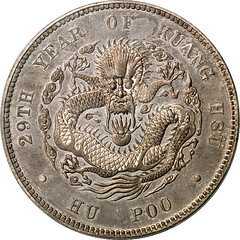
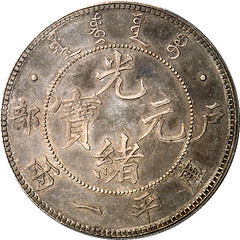
Reversed Dragon Pattern Dollar (Type II), Year 3 (1911). Tientsin Mint.
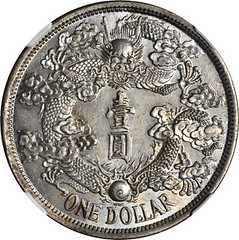
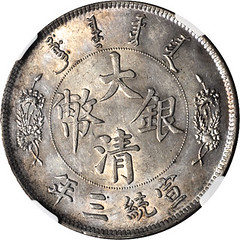
Reversed Dragon Pattern Dollar (Type II), Year 3 (1911).
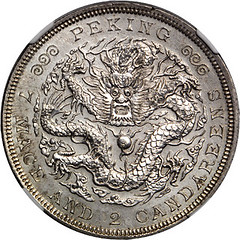
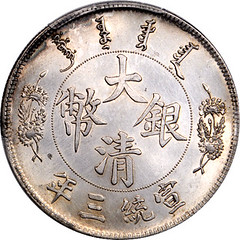
Kiangnan. 3 Mace 6 Candareens (50 Cents), CD (1900).
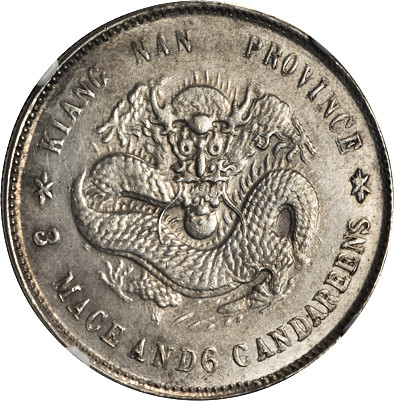
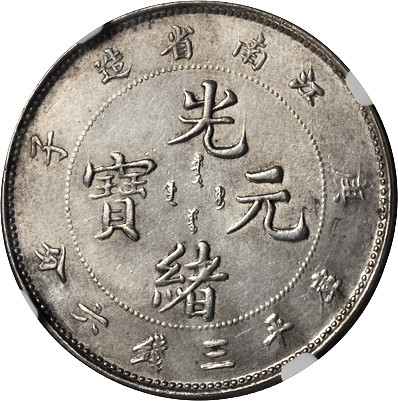
Fuzhou (Foochow). Imperial Gold Award Medal
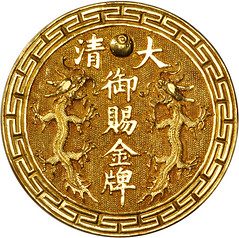

PROVINCIAL BANKS. Ili Official Currency Bureau. 2000 Cash, Yr. 1 (1909).
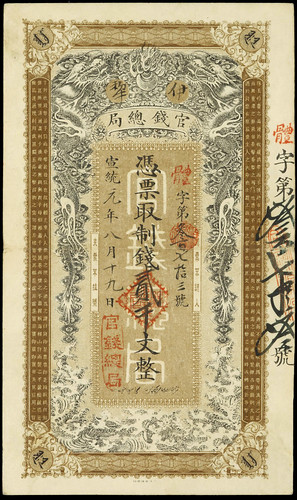
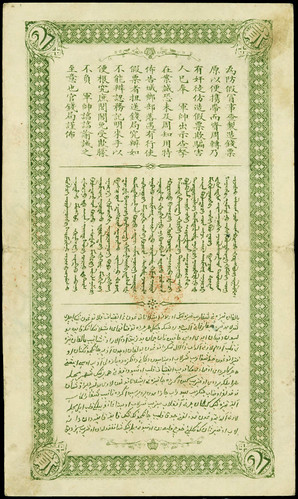
Hong Kong and Shanghai Banking Corporation. 500 Dollars, 1.1.1901.
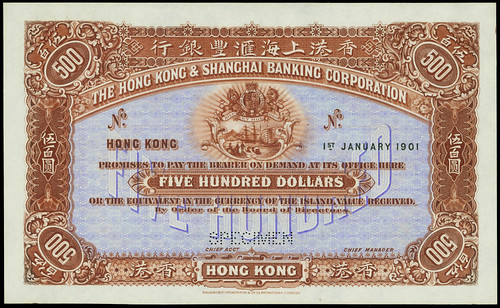
THE BOOK BAZARRE
HARLAN J. BERK’S 30 APRIL 2015 BUY OR BID SALE
 Exquisite ancient coins in Harlan J. Berk’s current Buy or Bid Sale
Exquisite ancient coins in Harlan J. Berk’s current Buy or Bid Sale
Coins of exceptional beauty often deriving from famous old collections are a specialty of Harlan J. Berk, Ltd. The firm’s latest Buy or Bid Sale, which closes on 30 April 2015, offers collectors a choice of 542 ancient coins, plus 21 coins of the world and 46 antiquities or antique maps.
The current catalogue covers the entire field of ancient numismatics, Celtic, Greek, Roman, and Byzantine, and includes a number of rarities or concentrated groupings that deserve special mention.
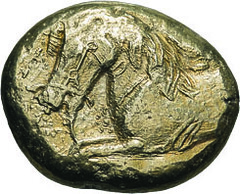
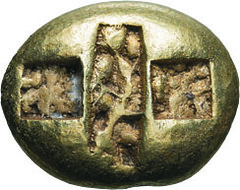
6 Ionia, uncertain mint. Electrum Stater, 625-600 BC. Weidauer-139
First, a spectacular electrum stater from Ionia, dating from c. 635-600 BC, with a reverse incuse reminiscent of those on Milesian staters, and showing on the obverse the forepart of a horse with bridle galloping left (lot 6; EF; $18,000).
A 1/48 stater from Phocaea, weighing only 0.28g, has as obverse type the detailed head of a griffin (lot 9; FDC; $3000). The ability of Greek die engravers to create intricate types on tiny dies is astonishing!
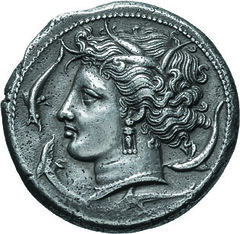
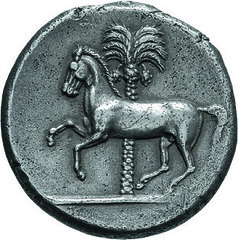
66. Siculo-Punic Tetradrachm, 350-300 BC. Jenkins III, 138.7 (this coin). From the Niggeler Collection
The head of Tanit-Persephone in the style of Kimon on Siculo-Punic tetradrachms is one of the masterpieces of Greek coin art. Berk’s catalogue contains a particularly attractive example with an excellent pedigree, coming from the Niggeler Collection (lot 66; EF; $17,500).
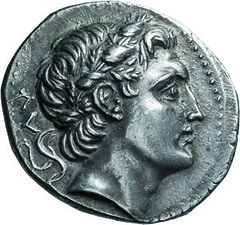
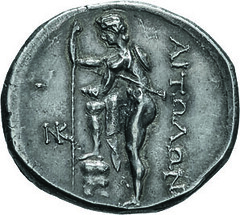
113 Aetolian League. Stater, 220-205 BC. Tsangari 93,
The Aetolian League played an important role in the history of Greece in the third and second centuries BC, but its coinage, in contrast, is very rare. Berk offers a choice example of the rare tetradrachm with the hero Aitolos on the reverse, which moreover has a pedigree going back to Jacob Hirsch’s sale of the Lambros Collection in 1910 (lot 113; EF; $12,500).
A stater of the Akarnanian League showing the forepart of the man-headed bull Achelous on the obverse derives from a sale held by the same Jacob Hirsch five years earlier, in 1905 (lot 112; EF; $15,500). The river Achelaos flowed along the border of Akarnania and its god was the most important river god in the Greek world, the mythological opponent of Heracles and father of the Sirens and of the Delphic fountain nymph Kastalia.

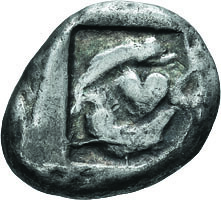
195 Barke, Cyrenaica. Didrachm, 490-470 BC. Unique
A didrachm of the city Barke, dating to c. 490-470 BC, must rank as one of the great rarities of Greek numismatics (lot 195; Good VF/ Fine+; $25,000). Showing a ram’s head and a silphium fruit on the obverse and a silphium fruit between two dolphins on the reverse, this unique coin is reported to have had a narrow escape in more recent times, being brought out of Libya in 1969 during Gaddafi’s putsch against King Idris.

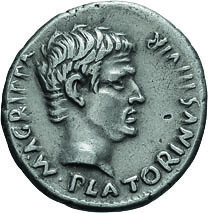
249 Augustus, 27 BC-14 AD. With Agrippa. Denarius, 13 BC. RIC-408
The catalogue includes an exceptional denarius of Augustus with portrait of Agrippa on the reverse (lot 249; aEF; $12,000), plus a large selection of other denarii of Octavian/Augustus in Fine to Good Very Fine condition at moderate prices.
The rest of the popular first century AD is also well represented, for example by nice denarii of Caligula, Galba, Vitellius and Children, and Julia Titi, plus a perfect denarius of Nero with a monumental portrait (lot 282; FDC; $8,500) and an interesting aureus of Titus as Caesar with the famous Cow of Myron on the reverse (lot 24; EF; $8,000).
There are also many choice rarities of the year 193, the Severan emperors, and the soldier emperors, for example denarii of Pertinax, Manlia Scantilla, Didia Clara, and Pescennius Niger; an antoninianus of Diadumenian; and an excellent sestertius of Gordian II Africanus (lot 404; VF; $6,000).
The collection of bronze coins of Constantine I and his sons brought together by the retired high-school teacher T. R. McIntosh includes some interesting rarities, in particular the second recorded specimen of a reduced follis from the mint of London whose obverse shows a figure of Victory on the shield held by Constantine (lot 480; EF; $1,500). McIntosh, who died in January 2015 while the present catalogue was being compiled, had long been a generous donor to the Harrisburg University of Science and Technology and to its library, which will be named after him. The money that his estate receives from selling this part of his coin collection will also be donated to that institution.
Harlan Berk has written two popular books about Byzantine gold and copper coins, so always tries to include a good selection of them in his catalogues. The current catalogue, for example, includes two rare Byzantine solidi whose small thick planchets show that they were struck at Carthage rather than Constantinople: solidi of Constans II (lot 36; FDC; $1,000) and Constantine IV (lot 37; EF; $1,400).
The catalogue closes with a selection of 21 modern coins from the middle ages up until the twentieth century, 39 antiquities, and seven old maps.
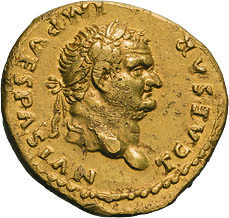
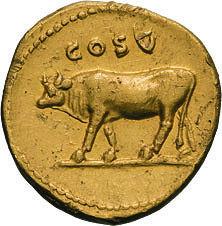
24 Titus as Caesar, 70-79 AD. Aureus, Rome, 76 AD. RIC-859
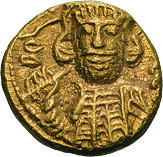
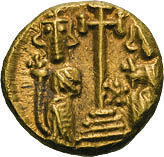
37 Constantine IV, 668-685 AD. Solidus, Carthage. Sear-1189
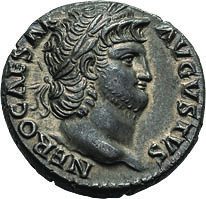

282 Nero, 54-68 AD. Denarius, 65-66 AD. RIC-60
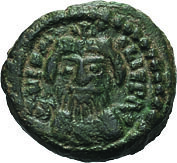
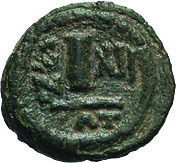
414 Heraclius, 610-641 AD. Decanummium, Catania, 621-2 AD. Berk-605. Sear-885.


422 Constans II, 641-641 AD. Half Follis, Syracuse, 651-2 AD. Berk-699. Sear-1113

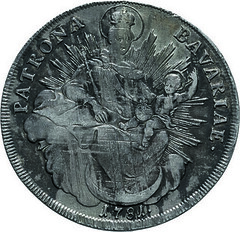
547 Bavaria. Karl Theodor, 1724-1799. Taler, 1781. Dav-1965
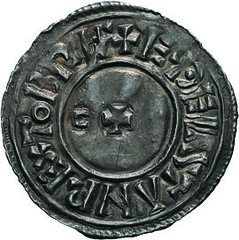
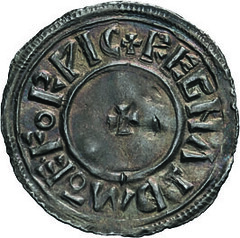
552 England. Aethelstan, 927-939. Penny. Sear-1093. Ex Schembri Collection.
The catalogue for the 193rd Buy or Bid Sale is accessible online at http://www.hjbltd.com/currentbbs/era.asp. Printed catalogues can be ordered from Harlan J. Berk, Ltd., 31 N. Clark Street, Chicago, IL 60602; tel. 312-609-0018; e-mail info@hjbltd.com
ARTICLE DISCUSSES HALF SHEKEL OF TYRE FIND
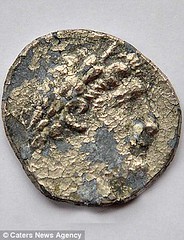
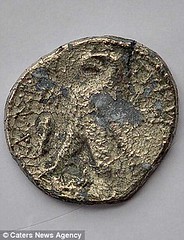
Coin collector Stephen Creswell snapped up what he thinks is a half shekel from Tyre - which dates back to 126BC - at an auction in Wolverhampton, Staffordshire.
The coins are believed by Biblical scholars to have been the same as those used to pay Judas Iscariot his 30 pieces of silver for betraying Jesus.
But one expert claims the coin is unlikely to be an original and believes Mr Cresswell might have a 'mock up'.
Professional numismatist Mike Vosper told MailOnline: 'I can confirm that this is not even a coin but either a contemporary forgery, although this is doubtful, or more like a modern mock up of a "coin" believed to be some kind of shekel.'
Mr Vosper, who runs Mike R Vosper Coins with his partner Viv, said it was the fabric of the coin and the fact that it has half its surface missing that gives it away.
Viv added: 'Some coins have surface deposits but nothing like that'.
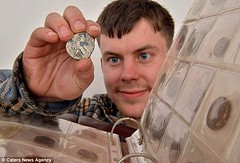 Mr Cresswell started attending auctions as a teenager and said he loved their competitive nature.
Mr Cresswell started attending auctions as a teenager and said he loved their competitive nature.
He said: 'Bidding against other people is part way between placing a bet and taking part in a competition.
'I hate leaving any auction empty handed. My home is full of quirky objects that I've picked up along the way. Without doubt, the half shekel is my favourite so far.'
To read the complete article, see:
Was this one of the 30 pieces of silver that Judas betrayed Jesus for? Coin bought for just £29 could date back to 126BC
(www.dailymail.co.uk/news/article-2977785/Was-one-30-pieces-silver-Judas-betrayed-Jesus-Coin-bought-just-29-date-126BC.html)
1643 ENGLISH CIVIL WAR DECLARATION POUND
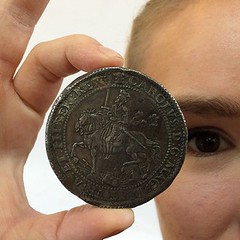 An extremely rare £1 coin from the start of the English Civil War has emerged for sale at auction with an estimate of £20,000 – but could go for up to £50,000.
An extremely rare £1 coin from the start of the English Civil War has emerged for sale at auction with an estimate of £20,000 – but could go for up to £50,000.
The solid silver “Declaration Pound” dates from 1643 and was struck in Oxford, a newly-forged seat of power for Charles I after he withdrew from London.
A new parliament was set up as was a mint at New Inn Hall that was created to launch an official currency in Royalist control.
The legend on the back of the coin translates as Let God arise and let His enemies be scattered.
It is literally a declaration of the King’s power and his belief in the “absolute monarch”. This coin is a rare survival from the last years of the doomed monarch’s reign.
The large coin that is over two inches across remains in very good condition and has been well kept over the years.
It was discovered when the owner took it into Duke’s auction house in Dorchester, Dorset, without knowing what it was.
Timothy Medhurst, a coin specialist and auctioneer at Duke’s, said it was the type of item he dreams of finding.
He said: “This coin marked Charles I’s attempts to regain his failing power and it represents a pivotal moment in the history of the British Isles.
“It is a coin which is rare to find and it will cause a stir in the coin collecting world.
To read the complete article, see:
1643 rare English Civil War Declaration Pound coin may fetch £50,000 at auction
(www.blackmorevale.co.uk/1643-rare-English-Civil-War-Declaration-Pound/story-26105624-detail/story.html)

MEDALS OF THE NAPOLEONIC ERA
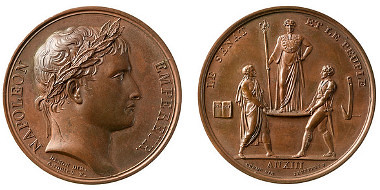
Bronze medal: Coronation of Napoleon in Paris 1804
Spring, 200 years ago. Napoleon slipped back to France from his exile on the island of Elba. The “Hundred Days” of his rule began. Once again, Napoleon tried to turn the wheel of time back in his favour. Only on 18 June 1815 did the nightmarish “scourge of Napoleon” end with his defeat at Waterloo.
Shortly after Napoleon’s abdication, a certain Mr. Palmer – a collector from London – went to the coin and medal mint in Paris and bought the entire set of over 130 bronze medals depicting the emperor. The tanner and bookbinder Gainier created a leather casing for the medals. It features an embossed imperial eagle and drawers with holes that precisely fit the size of each medal. This unique little coin cabinet tells the history of Napoleon between 1796 and 1815 in a fascinating way and is now on public display for the first time.
The medals themselves span an almost twenty-year period in which much of Europe – from Madrid to Moscow and from Berlin to Naples – was beset by war and suffering. The continued survival of the Principality of Liechtenstein, which was seriously affected by all these developments, hung in the balance.
This fateful time for Europe and for Liechtenstein is presented both in this unique collection of medals and in original documents from the Princely Collections that have never been available for public viewing until now. They include unique documents which other great rulers of the time – Emperor Franz I of Austria, Tsar Alexander I of Russia and King George III of the United Kingdom – had addressed to Prince Johann I. Militaria from the Princely Collections and other items on display enhance the whole picture which the exhibition intends to convey.
To read the complete article, see:
The Napoleonic era as mirrored in its medals
(http://coinsweekly.com/en/News/4?&id=3302)
THE TREATY OF GHENT MEDALS
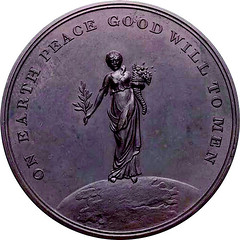
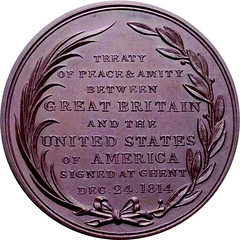
The War of 1812 had become a bloody conflict that had dragged on much longer than either the United States or Great Britain had anticipated.
Buoyed by the victory over Napoleon in March 1814 the British popular opinion turned to the war involving their North American colonies and to “giving Jonathan (the United States) a good drubbing.” Britain, looking for revenge because the United States had tried to stab her in the back (during Britain's war with France) in 1812 , had resisted the attempts by Czar Alexander I of Russia to broker peace negotiations in September 1813, despite the United States emissaries travelling to St. Petersburg. Unfortunately for Britain though, even adding thousands of Wellington’s crack troops to the fray failed to quickly end her war with the United States.
With the forced abdication of Napoleon, on April 11, the war in Europe came to an end. This meant that the Royal Navy no longer needed to enforce a blockade of American trade with France (actually, these orders had been repealed two days before the United States declared war on Britain); it also meant that Britain had no reason to continue the controversial practice of impressments of U.S. merchant marines into the Royal Navy.
the Americans dropped their demands for an end to British maritime practices and Canadian territory – ignoring their war aims – and both sides were now willing to adopt a status quo ante bellum position.
With the log jam now broken, proceedings began to move rapidly; an initial draft treaty consisting of 15 articles was tabled and debated. The British delegation agreed to nine articles, and two more were added. These final 11 articles became the Treaty of Ghent. It was officially signed on the evening of December 24, 1814.
All that stood in the way of peace now was for it to be ratified by each government. This was done by the British Parliament on December 30, 1814, and signed into law by the Prince Regent (the future King George IV.) The United States ratified the treaty some months later, in Washington, February 17, 1815.
There were two contemporary medals issued to commemorate the Treaty of Ghent. Both, struck in Britain, were originally described in Benson J. Lossing's Pictorial Field-Book of the War of 1812, published in 1869.
For more information about the Royal Canadian Numismatic Association, see:
www.rcna.ca
ADMISSION TICKETS & PASSES
Dublin, William and Mary, Theatre Royal
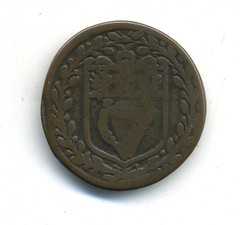
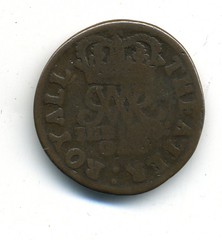
Dublin, William and Mary, Theatre Royal, bronze pass, circa 1690, a shield bearing the Irish Harp, rev. monogram WMR, (William and Mary Rex), THE . MID. GAL, 28 mm, (DW. 3/25). Good fine and very rare. £325 Ex. Panter Collection, Sotheby's 1929, lot 104
For more information, or to purchase, see:
www.historicmedals.com/viewItem.php?no=2003
Chelsea, The King's Private Roads

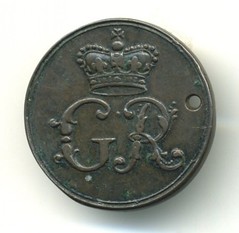
Chelsea, The King's Private Roads, bronze pass, 1731, GR with crown above, rev. monogram RA, THE/ KINGS/ PRIVATE/ ROADS/ 1731, 30 mm (DW 320/5), pierced for suspension. About extremely fine and very rare in this condition. £320
Originally a private road used by Charles II on his way to Hampton Court. Others could use it on the production of one of these passes. This was George III's favourite route to Kew and it ceased to be a private road only in 1830
For more information, or to purchase, see:
www.historicmedals.com/viewItem.php?no=1937
Stratford upon Avon, Shakespeare Jubilee Festival
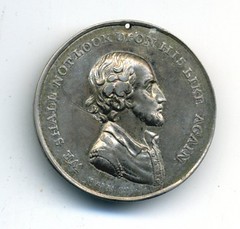
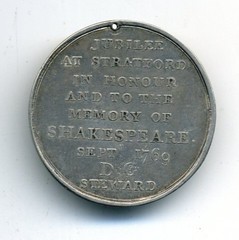
Stratford upon Avon, Shakespeare Jubilee Festival, silver pass, 1769, by J. Westwood, draped bust of Shakespeare profile right, SHALL NOT LOOK UPON HIS LIKE AGAIN (A QUOTE TAKEN FROM HAMLET, ACT 1, SCENE 2, rev. JUBILEE/ AT STRATFORD/ IN HONOUR/ AND TO THE/ MEMORY OF/ SHAKESPEARE/ SEPTR 1769/ D. G. / STEWARD, 32 mm, (BHM. 136), pierced for suspension. Some marks, very fine and scarce. £350
The initials D. G. on the reverse refer to David Garrick, Steward for the event who, after the oratorio in the Stratford great church, led a procession to the ampitheatre and then presided over a grand lunch. The festivities concluded with various musical performances and songs set to music by Dibden and Arne, ending with and address and epilogue by Garrick.
The Gentleman's Magazine of 1769 carries a letter from a correspondent attending the Festival in which he states that "my dress consisted of ... a silver medal of Shakespeare, pendant from a sky blue ribbon round my neck.". Also present was James Boswell, who , in his report, makes a similar reference, "We all wore, hung in a blue ribband at our breasts, a medal of Shakespeare, very well cast by Mr Westwood of Birmingham. On one side was the head of Shakespeare, and round it this inscription We shall not look upon his like again ..."
For more information, or to purchase, see:
www.historicmedals.com/viewItem.php?no=1643
London , Drury Lane
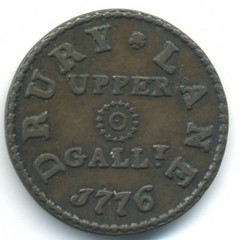
London , Drury Lane, , bronze pass, 1776, , DRURY LANE/ UPPER GALLY/ 1776, 31mm (DW. 19/209). Good very fine and rare especially in this condition. £165
For more information, or to purchase, see:
www.historicmedals.com/viewItem.php?no=1293
London, Westminster Bridge Road, Royal Circus and Amphitheatre
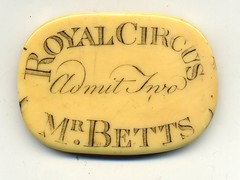
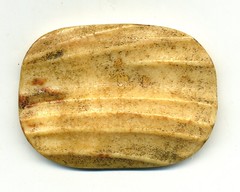
London, Westminster Bridge Road, Royal Circus and Amphitheatre, bone pass, circa 1800, Royal Circus/ Admit Two / Mr. Betts, 69 x 48 mm. Good very fine and very rare. £750
For more information, or to purchase, see:
www.historicmedals.com/viewItem.php?no=1443

THE SCHMANDT SALE AND THE BLIZZARD OF 1957, PART 2
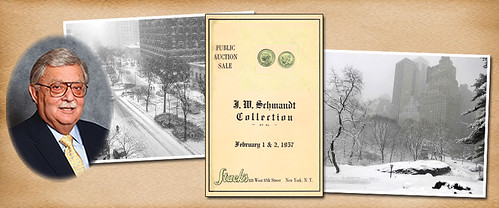
As I reported in my last story, the sale of the J.W. Schmandt Collection of United States Gold Silver and Copper Coins went forward on February 1 and 2, 1957, despite the record snowfall and the delays in transportation. According to the weather bureau this February storm was among the worst New York had experienced since they started to keep records in 1888.
As noted, collectors, dealers, and agents fought the foul weather to personally attend the sale. I remember hearing remarks such as: "This sale could be the chance of a lifetime, to go to an auction of great numismatics, with little or no competition." Many thought if they didn't go they would miss an opportunity to acquire wonderful items at fractions of the market price.
Well, some 250 or more attended the sale and the phones rang off the hook with collectors trying to get their bids in. The activity was fierce and the bidding intense. In contrast with what collectors may have expected, many who came saw the quality and rarity of the coins and thought: "Since I am here already, I might as well stay and buy some.” This led to bids on some coins that went even higher than market value.
When I asked attendees why they made this difficult journey, they almost universally answered (paraphrasing the U.S. Post Office motto): "Neither snow nor rain nor heat nor gloom stays the numismatist from his desire to improve his collection!”
As I remember this notable sale, I close my eyes and see the auction room full of great collectors and dealers who had made it through the storm to the sale. Among them I recall Louis Werner, Jerry Cohen, Harry Forman, John J. Pittman, Gaston DiBello, Max Kaplan, Harold Bareford, Martin Kortjohn, Oscar Schilke, James Kelly, John J. Ford, Joseph Spray, to mention just a few. As they waited for the sale to start, they discussed how “crazy” they were to have braved the storm, but all had been unwilling to miss this opportunity to add to their collections or holdings.
One dealer’s experience in the storm bears retelling. Jerry Cohen, a partner of Abner Kreisberg’s in California, came to New York a day or so before the storm hit. He looked at the lots, deciding what he might bid on, and also reviewed the Stack's inventory. While the streets were still passable he visited a few clients and other dealers in New York. Despite the worsening of the storm, nothing seemed to deter Jerry from "making his rounds." On the morning of February 1, as the storm intensified, Jerry decided to visit New Netherlands Coin Company, to see Charles Wormser and John J. Ford. As their offices were about 10 city blocks from Stack’s, he ventured out, walked down Fifth Avenue, and entered their building on the corner of Fifth Avenue and 47th Street, using the entrance located on Fifth Avenue (they had entrances on both streets).
After visiting awhile, Jerry decided to head back to Stack’s before the storm got any worse. So he left New Netherlands using the 47th Street door, starting off in the wrong direction. The snow was heavy, almost a whiteout situation, but Jerry kept going. About a half mile from where he started, he encountered a policeman and asked: “Where am I? I want to get to 57th Street and 6th Avenue." The officer replied: “You walked east rather than north. You are lucky you didn’t end up in the East River!" He redirected Jerry, now cold and somewhat frozen, in the right direction and Jerry finally arrived at Stack's.
As the auctioneer for that evening, I held the sale back till 7 pm to allow the late arrivals to take off their snow-covered clothing, have some coffee and get comfortable.
Virtually from the first lot offered the bidding was fast and furious. All wanted to get what they came for, at the same time hoping the session would end early so they could get back to their hotel rooms or homes as soon as possible.
To read the complete article, see:
Snow Versus the Collector, Part 2
(www.stacksbowers.com/NewsMedia/Blogs/TabId/780/ArtMID/
2678/ArticleID/64998/Snow-Versus-the-Collector-Part-2.aspx)
Last week I edited Dave Alexander's comment on the blizzard to read "1957", thinking he'd listed "1947" as a typo. It wasn't - sorry. Dave writes:
When I read Harvey Stack's memoir I read the date of the historic blizzard as 1947! That was indeed the worst in New York City history (if you lived through it) or second worst (if you had lived through the 1888 storm). In 1957 I was in my first year at the University of Miami and had been a collector eight years. What a difference a decade makes!
To read the earlier E-Sylum articles, see:
THE SCHMANDT SALE AND THE BLIZZARD OF 1957
(www.coinbooks.org/esylum_v18n08a19.html)
NOTES FROM E-SYLUM READERS: MARCH 1, 2015 : Dave Alexander on the Blizzard of 1957
(www.coinbooks.org/esylum_v18n09a12.html)
WHITMAN ANNOUNCES “SHARE YOUR HOBBY” PHOTO CONTEST
Whitman Publishing announces a numismatic photography contest with prizes up to $500 in retail value. The Whitman “Share Your Hobby” Photo Contest, for human-interest views of coin and paper-money collecting, is open to all photographers 18 and older and will run through the Fourth of July 2015. Entries will be judged by Whitman Publishing staff, Numismatic Director Q. David Bowers, and Red Book Senior Editor Kenneth Bressett. All submissions are eligible to be included in future Whitman books, and winners will be publicized at the American Numismatic Association World’s Fair of Money in Chicago, August 2015.
“Numismatics is about more than just accumulating round pieces of metal,” says Whitman publisher Dennis Tucker. “We’re looking for images of people enjoying their pursuit of the hobby. They might show grandparents with their grandchildren, collectors studying or displaying their coins and paper money, friends examining new purchases, or a hobbyist talking and laughing with a favorite coin dealer. The setting could be your den or home office, a coin show, a presentation at your local club, or the comfortable chair where you relax to read books. The only limits are your imagination and creativity.”
Entries may be old photographs or new.
Prizes are as follows:
First prize: $500 retail shopping at Whitman.com
Second prize: $250 retail shopping at Whitman.com
Third prize: $100 retail shopping at Whitman.com
(10) runner-up prizes: A copy of the new 1,504-page Guide Book of United States Coins, Deluxe Edition ($49.95 retail value)
Digital entries: Should be at least 6 megapixels. May be emailed to ShareYourHobby@whitman.com.
Print entries: Should be mailed to Whitman Publishing, Attn: Share Your Hobby Contest, 3101 Clairmont Road, Suite G, Atlanta GA 30329.
All entries: Include your name, mailing address, phone number, and email address. By entering the contest you grant permission for your photograph to be published by Whitman Publishing. A standard model-release form must be signed for any photographs showing people. The permission form and full contest rules are available at www.Whitman.com/ShareYourHobby .
MORE ON THE FINNISH “SISU” COIN
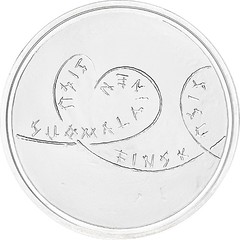
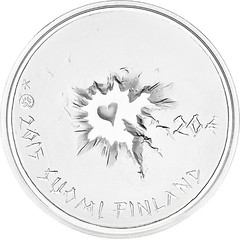
Mint of Finland has released the second official collector coin of 2015 on 28 February, the Day of Sisu. The coin was launched at the inauguration of the Year of Sisu 2015 in Helsinki. Organised by Filosofian Akatemia, the Year of Sisu 2015 brings together companies, organisations and individuals through events, challenges and projects.
“The idea of Finnish sisu as a motif for a collector coin arose during market research we carried out in 2014. Sisu has always taken the Finnish people forward in the face of adversity and put us on the world map. The Finnish sisu collector coin now struck conveys the story of the importance of sisu and also acts as a universal reminder of what can be achieved through perseverance. We’re delighted to be able to be part of the Year of Sisu with this collector coin,” says Mint of Finland Communications Director Henna Karjalainen.
According to Finnish sisu researcher Emilia Lahti, sisu begins where perseverance ends. “Sisu is more an individual decision to act than a personal quality,” Lahti explains. In her doctoral thesis currently under preparation, Lahti examines sisu as a universal capacity and dynamic mindset for action.
The Finnish sisu collector coin combines sensitivity and strength. The obverse of the coin features two delicately carved hearts joined together. The heart pushing through the tear on the reverse side of the coin and three-dimensionality are striking features. The collector coin was designed by artist Tapio Kettunen. Mint of Finland’s silver collector coins bear the Key Flag label attesting to their Finnish origin.
To read the complete article, see:
A new collector coin for the Finnish “Sisu”
(http://coinsweekly.com/en/News/4?&id=3307)
To read the earlier E-Sylum article, see:
SOME RECENT COIN DESIGNS: MARCH 1, 2015
(www.coinbooks.org/esylum_v18n09a31.html)
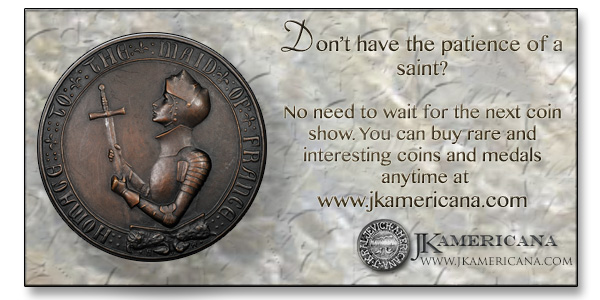
PUTIN GIVES USHAKOV MEDAL TO ROYAL NAVY VET
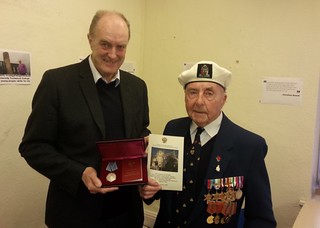 A proud Royal Navy veteran has received a rare medal from the Russian military for his courageous service during the Second World War’s Arctic Convoys.
A proud Royal Navy veteran has received a rare medal from the Russian military for his courageous service during the Second World War’s Arctic Convoys.
Mr Jim Bates, who served as an Able Seaman on board the destroyer HMS Wilton, has been awarded the Ushakov medal, verified by no less than Russian President Vladimir Putin.
Jim, the president of the Burnley and Padiham Royal British Legion, received the medal from Burnley MP Gordon Birtwistle who collected it from the Russian Embassy in London.
Sabden-born Mr Bates (93) said: “I am very proud to receive this medal after so many years. Last year, our government finally decided to award us the Arctic Star and now we have received this.
“I just feel sorry for all the lads who didn’t live to receive the medal, either being killed during the war or dying in the years since.”
The Arctic Convoys saw about 1,400 merchant ships deliver essential supplies to the Soviet Union under the Lend-Lease programme, escorted by ships of the Royal Navy, Royal Canadian Navy, and the U.S. Navy.
“It was a rough time. We were bombed from the air and by U-boats nearly all the way once we left British waters.
“It was extremely cold and we had a few close shaves but it was so important. We were taking arms and food out to the Russians and taking their timber back to Britain.
“The convoys helped the Russians to beat the Germans in the East so it was vital to the war effort.”
To read the complete article, see:
Russian president Vladimir Putin honours war hero Jim
(www.clitheroeadvertiser.co.uk/news/local/russian-president-vladimir-putin-honours-war-hero-jim-1-7139608)
A SUFFRAGETTE SOCIETY MEDAL
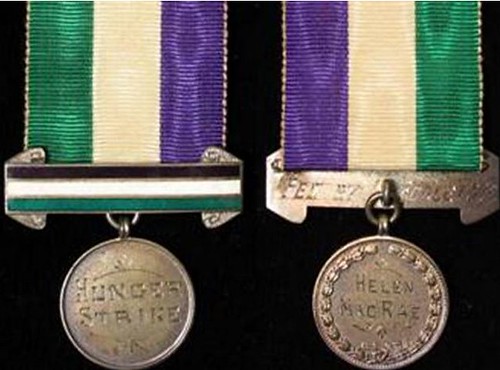
Heroic Kent suffragette's medal will be going under the hammer in Suffolk this month.
Helen MacRae, who was originally from Edenbridge, was a member of the East Grinstead Suffragette Society, and her silver hallmarked medal will be put up for auction on March 21, in Ipswich.
Part of the suffragette movement, MacRae was arrested for breaking windows in Whitehall and was forcibly fed after going on hunger strike in 1911.
Lockdales, the auctioneers of Martlesham near Ipswich, have put a guide price on the rare medal between £4,500 and £5,500 - and it comes in it's original casing, which has been personally engraved by MacRae.
On one side it reads "For Valour" and the other reading "Fed by Force".
To read the complete article, see:
Edenbridge suffragette medal is going up for sale in Suffolk
(www.kentonline.co.uk/sevenoaks/news/medal-of-suffragette-goes-under-32837/)
CAMPAIGN LOBBIES TO PUT A WOMAN ON THE TWENTY
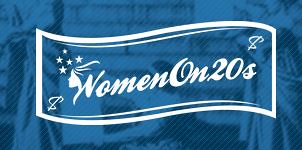 For decades, Barbara Ortiz Howard has owned an exterior-restoration business in Mount Vernon, just north of the Bronx; she is used to being the only woman among men. Several years ago, she began to think about another male-dominated part of her life, to which she had previously paid little attention: the portraits on U.S. banknotes. Each of the eleven denominations in circulation, from the one-dollar bill to the ten-thousand-dollar bill, depicts a man. They include eight Presidents (George Washington, Thomas Jefferson, Abraham Lincoln, Andrew Jackson, Ulysses S. Grant, William McKinley, Grover Cleveland, and James Madison), two Treasury Secretaries (Alexander Hamilton and Salmon Chase), and the unclassifiable Benjamin Franklin. The people featured on the banknotes haven’t changed since 1929.
For decades, Barbara Ortiz Howard has owned an exterior-restoration business in Mount Vernon, just north of the Bronx; she is used to being the only woman among men. Several years ago, she began to think about another male-dominated part of her life, to which she had previously paid little attention: the portraits on U.S. banknotes. Each of the eleven denominations in circulation, from the one-dollar bill to the ten-thousand-dollar bill, depicts a man. They include eight Presidents (George Washington, Thomas Jefferson, Abraham Lincoln, Andrew Jackson, Ulysses S. Grant, William McKinley, Grover Cleveland, and James Madison), two Treasury Secretaries (Alexander Hamilton and Salmon Chase), and the unclassifiable Benjamin Franklin. The people featured on the banknotes haven’t changed since 1929.
In the summer of 2012, she began toying with the idea of trying to get a woman on a banknote, but she didn’t quite know where to start. She e-mailed some friends (“HI SISTERS!” her message began) to ask them which women they would put on bills if it were up to them.
Among the e-mail’s recipients was an old friend of Howard’s, Susan Ades Stone. Ades Stone is a journalist, and she saw the potential for a serious campaign. Together, Howard and Ades Stone decided to mount an organized effort to put a woman on a bill by 2020, the centennial of women’s suffrage. They settled on the twenty-dollar note, not only because of its resonance with the anniversary year but because they thought that Andrew Jackson was the best candidate for removal from U.S. currency.
Howard and Ades Stone registered their nonprofit, called Women on 20s, and recruited others, including a co-founder of the National Women’s History Project, to join the campaign. Over several months, they built a Web site, and started a Twitter feed and a Facebook page. On Sunday, Women on 20s began inviting people to visit the site and vote for their favorite candidates to replace Jackson on the twenty-dollar bill; the choices include Alice Paul, Betty Friedan, Shirley Chisholm, Sojourner Truth, Rachel Carson, Rosa Parks, Barbara Jordan, Margaret Sanger, Patsy Mink, Clara Barton, Harriet Tubman, Frances Perkins, Susan B. Anthony, Eleanor Roosevelt, and Elizabeth Cady Stanton. The women were selected from a longer list of a hundred names based on their societal impact and the difficulties they faced in pursuing their goals.
I asked Matthew Wittmann, a curator at the American Numismatic Society, which is dedicated to studying currency, what he thought of the campaign’s chances. He told me, “2020 seems doable, and Jackson seems like the low-hanging fruit as Presidents on the currency goes, so I think they probably have a shot.” (He also pointed out that, in the nineteenth century, before paper bills became prevalent, most of the money in circulation were coins that did picture a woman: Lady Liberty.
To read the complete article, see:
A Campaign to Put a Woman on the Twenty-Dollar Bill
(www.newyorker.com/business/currency/a-campaign-to-put-a-woman-on-the-twenty-dollar-bill)
For more information, see:
www.womenon20s.org

CANADIANS ASKED TO QUIT "SPOCKING" BANKNOTES
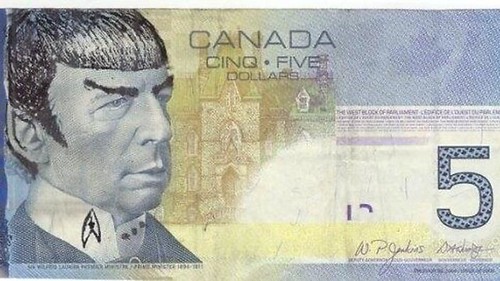
In a trend dubbed "Spocking," Canadians have taken to drawing pointy ears and tiled brows on top of Canada's seventh prime minister, Sir. Wilfrid Laurier, to make him look like Dr. Spock, the half-Vulcan, half-human Star Trek character made famous by Nimoy.
The "Spocking" trend has lead to Twitter hashtags #Spocking and #Spockingfives along with pictures of people's various designs.
It has also led the Bank of Canada to issue a statement urging people to please stop. While it is not illegal to deface Canadian bills, "there are important reasons why it should not be done," Bank of Canada spokeswoman Josianne Menard told USA TODAY in an emailed statement.
Menard cited practical reasons, as well as "national pride."
"Writing on a bank note may interfere with the security features and reduces its lifespan. Markings on a note may also prevent it from being accepted in a transaction," she said.
"Furthermore, the Bank of Canada feels that writing and markings on bank notes are inappropriate as they are a symbol of our country and a source of national pride."
But the trend continued on Tuesday with people posting their drawings on Twitter — including from countries like the U.S. and Scotland.
To read the complete article, see:
Bank of Canada urges Leonard Nimoy fans to stop 'Spocking' bank notes
(www.sbs.com.au/news/article/2015/03/05/bank-canada-urges-leonard-nimoy-fans-stop-spocking-bank-notes)

To read the complete article, see:
Bank spokesman says writing on bills "inappropriate"
(http://m.bbc.com/news/world-us-canada-31717210)
To read the earlier E-Sylum article, see:
CANADIANS HONOR LEONARD NIMOY WITH "SPOCK" NOTES
(www.coinbooks.org/esylum_v18n09a30.html)
BANKNOTE BAD BOY W.L. ORMSBY

I’ve always wondered about Waterman Lily Ormsby. He was the “renegade bad boy” member of the bank note engraving community and was always considered an outsider. Ormsby had a knack for being involved with banks and bankers that weren’t “quite right.” Perhaps it was because he asked fewer questions of his prospective customers or was willing to work on thinner margins than the “big boys” in the bank note business. In any case, the vast majority of his bank customers were either outright frauds or fragile short-lived ventures. The Boone County Bank of Lebanon, Ind., was one such customer. W.L. Ormsby did notes for the bank under the name of the New York Bank Note Co. Contemporary documents and records document the deception that involved Ormsby.
To read the complete article, see:
Engraver W.L. Ormsby had a knack for involvement with short-lived banks
(www.coinworld.com/insights/Engraver-W-L-Ormsby-was-a-renegade-bad-boy.html)
JIM HALPERIN ON POLITICAL COLLECTIBLES
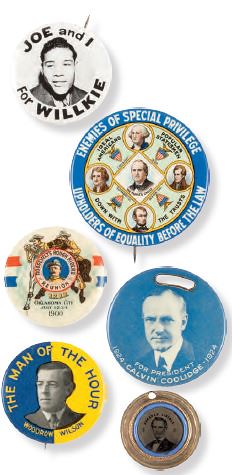 Heritage is in the process of
auctioning the legendary Merrill C.
Berman political collection. This
seems to be a good time to ask
why you collect in this category.
Heritage is in the process of
auctioning the legendary Merrill C.
Berman political collection. This
seems to be a good time to ask
why you collect in this category.
I guess I first became aware of the political item hobby in 1981, when I ran New England Rare Coin Auctions, before it merged with Steve Ivy’s coin company to become Heritage. NERCA handled the auction sale of what was at that time probably the best political collection that had ever come to market, the Don Warner collection. As a longtime devotee of American history, I was captivated by these campaign collectibles. I’d never seen anything like them! As objects, they were colorful and fun. Each one seemed like a portal to the electoral battles of generations past. The timing wasn’t right for me to embark on a new hobby, but over the years I often thought wistfully of the fascinating pieces in the Warner collection.
What, in your view, has most recently brought attention to this category?
In the early 1990s, the esteemed historian Arthur Schlesinger Jr. was editing a two-volume series of essays by various authors dealing with each American presidential election. His co-editor, University of Pennsylvania professor of history Fred Israel, was himself a leading collector of 19th century political campaign flags, and encouraged him to visit a friend in New Jersey who had amassed one of the most comprehensive collections of campaign items from buttons to banners dating back to George Washington. Schlesinger was reportedly “blown away” by what he saw, and couldn’t stop enthusing about how important these artifacts are in illustrating and understanding our political traditions. When their book, Running for President, was published by Simon & Schuster in 1994, it was lavishly illustrated with items from the collection of that New Jersey hobbyist, David J. Frent. Those are wonderful volumes, and although long out of print can still be found for sale on the Internet, and they provide a great introduction to political items in their historical context.
So what’s attractive about this category?
The political item market exhibits some intriguing qualities for a collector/ investor like me. The historical importance of these pieces assures that there will always be demand for them. This is no passing fad like Beanie Babies! There is already a well-established collector base, anchored by the American Political Items Collectors association, founded in 1945. This organized hobby has created an orderly and stable marketplace for political collectibles. On the whole, prices have risen slowly and relatively steadily. A Cox-Roosevelt jugate button worth $2,000 in the 1970s will fetch around $25,000 today. But it has been estimated that the total annual auction sales for political items in a range of venues still total less than $10 million – such a tiny market given its obvious appeal.
To read the complete issue, see:
//www.intelligentcollector.com/mag/2015-2/offline/download.pdf
THE BOOK BAZARRE
ON THE TRAIL OF AN 1804 DOLLAR IMAGE
Dave Bowers writes:
Where did this picture of an 1804 dollar come from? It illustrated a story by Stephen King in the latest issue of The New Yorker. It deals with a murder in a Dakota town in the late 19th century. A silver dollar was stolen, but there was no mention of the date on it.

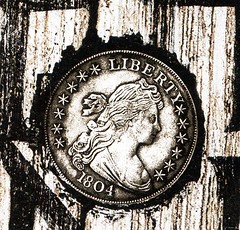
Dave's son Wynn writes:
I vote for this one: I think I see the same field shading and marks across the hair in line with the ribbon. The New Yorker photo cropped it.
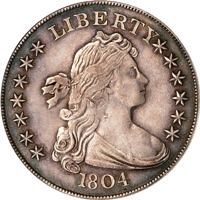

To read the complete article, see: 1804 Class III Silver Dollar - The King of US Coins (www.the-bna.com/photo_gallery/COTW-Archive/1804-Class-III-Silver-Dollar.html)
Dave writes:
My gosh, I think you are right! Without the Internet this would have taken a long time!
Ken Bressett writes:
No question about this being the same piece that Wynn has spotted. I was just about to say it definitely is a Class III “restrike”, and most likely the Davis specimen. I believes this confirms it.
Joel Orosz writes:
I hereby nominate Wynn for the position of Official 1804 Dollar Photo Identifier--as soon as someone officially creates that position!
Wynn writes:
Give Google credit, too. I dropped my cropped picture into Google Images and it recognized it as an 1804 dollar! Of course I already knew that, so that didn't actually help, but it was impressive anyway. Then I asked Google for images of 1804 dollars and looked for the right fields.
HAPPY PI DAY OF THE CENTURY!
 As numismatists we should all be familiar with Pi basics associated with the roundness of coins such as [Circumference] = PI * [Diameter] which is true for most all round coins unless they have been edge whacked a good one. Bill Penzey of the Penzey Spice Company, an online retailer of spices (who by the way sells wonderful Apple/Pumpkin Pie Spices) alerts us to the fast approaching “Pi Day of the Century.” Bill says:
As numismatists we should all be familiar with Pi basics associated with the roundness of coins such as [Circumference] = PI * [Diameter] which is true for most all round coins unless they have been edge whacked a good one. Bill Penzey of the Penzey Spice Company, an online retailer of spices (who by the way sells wonderful Apple/Pumpkin Pie Spices) alerts us to the fast approaching “Pi Day of the Century.” Bill says:
“The Pi Day of the century, 3.14/15 is only a little over a week away. For a time now Pi Day has been all about fun and of course pie, but with the way in recent years, science and even reality itself have come more and more under attack, I’m thinking maybe this year it’s time for Pi Day to emerge as something more than just fun.
For so much of our history, the people of our country and the world have benefited greatly from the science-based reality that has shaped America’s future. Science may be based on numbers, but science's actual value is in its humanity. It's beyond doubt that through science and the honest representation of reality our lives have become safer, healthier and happier. Yet today the very science that has done so much to reduce suffering in our lives is now under attack.
From the climate, to vaccines, to Wisconsin's own Governor Walker’s belief that there are more votes in denying evolution than there are in embracing it, clearly somewhere something has gone very wrong. There is more than enough blame to go all around for how we got here, but maybe this is one of those times that where we are is not nearly as important as where we need to be. Maybe rather than a debate of our differences, what we need is a celebration of what we share.
At Penzeys we think Pi Day could grow into just the holiday we need. There really is no time to lose to get on to celebrating the truth of science-based reality and the math behind it. And there is also no time better than now to get back to celebrating the kindness, compassion and the nurturing nature of our shared humanity that has always been behind the very best that science has brought to our lives.
In Pi, the number is all the value and beauty and wonder that is at the heart of the reality science holds. In the gift of a good slice of pie, the desert is all the kindness and compassion that our shared humanity encompasses. Pi Day really is ready to become so much more. And could there be a better day to relaunch Pi Day as the holiday we truly need than 3.14/15; the Pi Day of the Century…”
I’m all for Pi Day a la mode! Now the great alignment of the spheres, a once in a lifetime event, comes at 9:26 AM and approximately 53.5 seconds on the morning of Pi Day, Saturday March 14th, 2015 when time itself will align to the tenth digit with the universal irrational constant of PI, which as we all know equals about 22/7 or 3.1415926535…..
So what will you be doing at approximately 3/14/15 at 9:26:53 AM? I encourage you to go out and make a difference through teaching Science Technology Engineering and Math (STEM), of course use coins as examples of roundness whose parameters must be discovered by youth, not yet holding Pi in esteem, or perhaps you may only esteem holding a piece of pie at breakfast; then I bid you raise a glass of juice to the irrational numbers of this world, making the world go round.
For more information on Pi Day, see:
www.piday.org
LUNATIC ASYLUM TOKENS
David Powell writes:
 From the A-sylum to the E-sylum! just acquired, an approximately heller/groschen/pfennig-sized token from the Klosteneuburg Irrenanstalt, alternatively the Lower Austrian "State Lunatic Asylum" at Klosterneuburg, an establishment which was active from c.1869/70 to c.1920/22. Whether the denomination of the piece equated with any of those monetary units is anybody's guess; the unit of currency may just have been internal. The actual diameter is just under 18mm and the design is the same on both sides.
From the A-sylum to the E-sylum! just acquired, an approximately heller/groschen/pfennig-sized token from the Klosteneuburg Irrenanstalt, alternatively the Lower Austrian "State Lunatic Asylum" at Klosterneuburg, an establishment which was active from c.1869/70 to c.1920/22. Whether the denomination of the piece equated with any of those monetary units is anybody's guess; the unit of currency may just have been internal. The actual diameter is just under 18mm and the design is the same on both sides.
Amongst the various information available about the issuer online, almost all in German, is this fairly reasonable translation:
http://translate.google.co.uk/translate?hl=en&sl=de&u=http://www.psychiatrische-landschaften.net/node/168&prev=search
FEATURED WEB PAGE: NEW YORK COIN & STAMP CO
This week's Featured Web Page is the Numismatic Bibliomania Society Wiki page on the New York Coin & Stamp Company Auction Sale Catalogues, built by Tom Wetter with the help of NBS members.
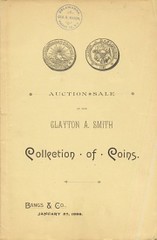
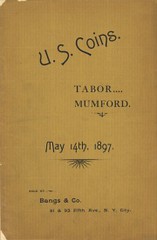
http://wiki.coinbooks.org/index.php/NEW_YORK_
COIN_%26_STAMP_COMPANY_AUCTION_SALES
